#but it had to be simplified for a 6 year old
Explore tagged Tumblr posts
Text

Exhibition 1793-1794 at the Carnavalet Museum (Part I)
For anyone interested in the French Revolution, a visit to the Carnavalet Museum is essential. Though the museum covers the history of Paris from its very beginnings to the present, it’s also home to the world’s largest collection of revolutionary artefacts. Which makes sense, given that Paris was the epicentre of it all.
Frankly, if you plan to explore it all, you’ll want to set aside a good 3–4 hours. For those focused solely on the French Revolution, head straight to the second floor, where you can get through the collection in under an hour. Best of all, the permanent collection is free, making it a brilliant way to spend an afternoon in the city on a budget.
Currently, though, there’s a special treat on offer. Running from 16 October 2024 to 16 February 2025, the museum is hosting an exhibition dedicated to my favourite (and arguably the most chaotic) year of the revolution: Year II (1).
Now, since the family and I were in Reims for a long weekend, I somehow managed (possibly after too much Champagne) to convince my husband to drive 150 kilometres to Paris just so I could see Robespierre’s unfinished signature. It helped that the kids were on board, too. Yes, the four-year-old fully recognises Robespierre by portrait. The one-year-old is, predictably, indifferent.
So, slightly worse for wear after a ridiculous amount of Champagne tastings, off we went to the museum.

1. Why Year II?
Because it was a catastrophe. No. Really. Let me explain, in a very overly-simplified summary:
In Year II, France was plunged into an unparalleled storm of internal and external crises that would define the Revolution’s most radical year and ultimately mark its turning point.
Internally, the government was riven by factional divides, economic collapse, and civil war. The Jacobins (2) took control of the Convention, sidelining the federalist Girondins (3), aligning themselves with the sans-culottes (4), and arguing that only extreme measures could preserve the Revolution. Meanwhile, the more radical Enragés (5) demanded harsh economic policies to shield the poor from spiralling inflation and food shortages. The Convention introduced the Maximum Général (6) to placate them, which capped essential prices; however, enforcement was haphazard, fuelling discontent across the country. At the same time, the Indulgents (7) called for a reduction in violence and a return to clemency.
Externally, France’s situation was equally dire, encircled by the First Coalition—a formidable alliance of Britain, Austria, Prussia, Spain, and the Dutch Republic, all intent on crushing the Revolution before it spread further. With the execution of Louis XVI, France found itself diplomatically isolated, and the army was, frankly, a shambles. Most officers were either nobles or incompetent (8), and the soldiers were inadequately trained and equipped. In a desperate bid to defend the Republic, the Convention issued the Levée en Masse (9) in August 1793, sparking revolts in many cities and outright civil war in the West.
Confronted with this barrage of existential threats, the Convention dialled up its response in spectacular fashion, unleashing what we now know as the Terror—a period of sweeping repression backed by some rather questionable legislation. As you can likely guess from the name alone, this was a brilliant idea…
Put simply: by the end of Year II, nearly all the key figures who had spearheaded the Revolution up to that point were dead. And no, they didn’t slip away peacefully in their sleep from some ordinary epidemic. They met their end at the guillotine.
In short, Year II wasn’t just the Revolution's most radical and defining phase—it was also the year the Revolution itself died. Yes, the Revolution, in its truest, purest, most uncompromising form, met its end the moment the guillotine's blade struck Robespierre’s neck.
2. Overview of the exhibition
The visit opens with the destruction of the 1791 Constitution and closes with Liberty, an allegorical figure of the Republic depicted as a woman holding the Declaration of the Rights of Man in her right hand. In between, the experience is structured around five main themes:
A New Regime: The Republic
Paris: Revolution in Daily Life
Justice: From Ordinary to Exceptional
Prisons and Execution Sites
Beyond Legends
More than 250 artefacts are featured, including paintings, sculptures, decorative arts, historical items, wallpapers, posters, and furniture. The layout is carefully structured around these themes, with a distinct use of colour to set the tone: the first three sections have a neutral palette, while the final two glow in vivid red, creating a very nice change in atmosphere.
What I appreciated most was how the descriptions handle the messy legacy of Year II. The texts actually admit that, while some Parisians saw this year as a bold step towards equality and utopia, for others it was an absolute nightmare. This balance is refreshing, even if things are a bit simplified (because how could they not be?), and it gives a well-rounded view of a wildly complicated time.
In this first part, I'll focus on the first two sections, as the latter three fit together neatly and deserve a deep dive of their own. Besides, there's so much to unpack that I'll likely exceed Tumblr's word limit (and the patience of anyone reading this).


3. A New Regime: The Republic
The first section covers the shift from the Ancien Régime to the First Republic, and, fittingly, it starts with a smashed relic of the old order: the Constitution of 1791. After the monarchy’s fall and the republic’s proclamation in September 1792, the old constitution was meaningless. Though it technically remained in force for a few months, it was replaced by the Constitution of Year I in 1793, marking the end of France’s brief experiment with a constitutional monarchy. In May 1793, the old document was ceremonially obliterated with the “national sledgehammer”—a bit dramatic, perhaps, but Year II was nothing if not dramatic.


This section zeroes in on the governance of the new republic, featuring the Constitution of Year I, portraits of convention members, objects from the Committee of Public Safety and the National Convention (including a folder for Robespierre’s correspondence), and national holiday memorabilia. There’s even a nice nod to Hérault de Séchelles (10) as a principal author of the republican constitution.

3.1 Martyrdom as a political tool
Interestingly, the exhibition places a heavy emphasis on the concept of martyrdom. A significant portion of this first area is dedicated to the Death of Marat (11) and, to a lesser extent, the assassination of Le Peletier (12). It’s a clever angle since martyrs—whether well-known figures or nameless soldiers—have always been handy for rallying public opinion. The revolutionary government of Year II understood this all too well and wielded the concept to its full advantage.

In this spirit, the middle of this section features a reproduction of David’s Death of Marat, several drawings from Marat’s funeral, Marat’s mortuary mask, a supposed piece of his jaw, and more. Notably absent are any issues of L’Ami du Peuple, as though the display suggests Marat’s death was more impactful to the Republic’s narrative than his actual writings. I’d agree with that—the moment he died, he was elevated to a mythic status, and his legacy as a martyr of Year II took on a life of its own.



4. Paris: Revolution in Daily Life
While the first section focuses on the workings of governance, this part delves into Year II’s impact on ordinary Parisians. This period stands out for two reasons: France was in economic and political turmoil (wars, both internal and external, aren’t exactly budget-friendly), yet it also managed to introduce some remarkably forward-thinking legislation aimed at improving the lives of the common people.

4.1 The Paris Commune & Paranoia
To understand life in Paris during Year II, we can’t overlook the role of the Paris Commune (13). Rooted in the revolutionary spirit of the Estates General of 1789 and officially formalised by the law of 19 October 1792, the Commune was the governing body responsible for Paris. Divided into forty-eight sections, each with its own assembly, it gave citizens a strong voice in electing representatives and local officials. Led by a mayor, a general council, and a municipal body, the Commune handled essential civic matters like public works, subsistence, and policing.
From 2 June 1793 to 27 July 1794 (the height of Year II), the Commune implemented the policies of the Montagnard (14) Convention, which aimed to build a social structure grounded in the natural rights of man and citizen, reaffirmed on 24 June 1793. This social programme sought to guarantee basic rights such as subsistence (covering food, lighting, heating, clothing, and shelter), work (including access to tools, raw materials, and goods), assistance (support for children, the elderly, and the sick; rights to housing and healthcare), and education (fostering knowledge and preserving arts and sciences).
All this unfolded in an atmosphere thick with paranoia and intense policing; enemies were believed to lurk everywhere. The display does a solid job of capturing this side of the Paris Commune, featuring various illustrations that urged people to conform to new revolutionary norms—wear the cockade, play your part in the social order, fight for and celebrate the motherland, and so on.


One of my favourite pieces was the record of cartes de sûreté (safety cards) from one of the 48 Parisian sections. Made compulsory for Parisians in April 1793, these cards were meant to confirm that their holders weren’t considered “suspects” in a climate thick with paranoia. This small, seemingly random document—issued or revoked at the discretion of an equally random Revolutionary Committee—had the power to decide a person’s freedom or the lack of it.

At the risk of sounding sentimental, in the study of history, we often focus on broad events and overlook the "little guy" who lived through them. But here, this record reminds us that behind each document was, in fact, a real person. And that this very real person was trying to make their way through a reality that, 230 years ago, must have felt stifling and, at times, terrifying.
4.2 Education
A significant spotlight is rightly placed on education in this exhibition section, given the sweeping changes it underwent during the Revolution.
Before 1789, Paris was well-supplied with educational institutions. Eleven historic colleges and a semi-subsidised university offered prestigious studies in theology, law, medicine, and the arts, drawing students from across France. Inspired by Enlightenment ideals, boarding schools and specialised courses in subjects like science and mathematics had sprung up, mainly catering to the middle class, while working-class children attended charity schools. Private adult education also provided technical and scientific training. The catch? Most of these were church-operated.
Revolutionary policies targeting the Church caused a mass departure of teachers, financial difficulties, and restrictions on hiring unsalaried educators. Military demands, economic turmoil, and protests added to the strain on schools. Even the Sorbonne (15) was shut down in 1792, and by late 1793, nearly all Parisian colleges were closed except for Louis-le-Grand (16), which was renamed École Égalité. With the teacher shortage and soaring inflation, a handful of institutions struggled on.
This left the Convention and the Paris Commune scrambling to find new ways to educate the young, and they rose (or at least attempted to rise) to the occasion. On 19 December 1793, the Bouquier Decree aimed to establish free, secular, and mandatory primary education—a remarkable move, though it never fully materialised due to lack of funding.

With France at war, the Convention turned public education towards the needs of a nation in crisis. Throughout 1793 and 1794, new scientific and technical programmes sprang up to meet urgent demands, combat food shortages, and push social progress. Thousands of students were trained in saltpetre refinement (vital for gunpowder), and scientific knowledge spread beyond chemists to artisans and tin workers. In the final months of Year II, a saltpetre refinement zone was set up, the École de Mars was founded to rapidly train young men in military techniques, and the École Centrale des Travaux Publics (future École Polytechnique) was established to develop engineers in military-technical fields.


The education display features a fascinating array of educational degrees, lists of primary school students, and instructor rosters. Although a bit more context on the educational upheaval would have been helpful, the artefacts themselves are intriguing. Placed in the context of the rest of the exhibit, it’s clear that the new educational system wasn’t just about breaking away from the Ancien Régime; it was also very deliberately and openly crafted to instil republican ideals. Nothing illustrates this better than the way Joseph Barra(17) was promoted as a model for students at the École de Mars.
And, of course, this section also showcases one of the most enduring legacies of the Revolution: the introduction of the metric system and modern standardised measurements.


4.3 The (lack of) Women in Year II
The women of Year II were not real women. They were symbols—or so the imagery from the era would have us believe. There is shockingly little about the actual experiences of women in the collective memory of Year II.
Women played active roles in the Revolution. They filled the Assembly’s tribunes as spectators, mobilised in the sections, founded clubs, joined public debates, signed petitions, and even participated in mixed societies. In many cases, they worked side by side with men to bring about the Republic of Year II. So where are they?
Well, they’re certainly not prominent in this exhibition—but that’s not the fault of the organisers. It’s a reflection of how the time chose to represent them. In revolutionary imagery, women became allegories: symbols of Liberty, wisdom, the Republic, or the ideal mother raising citizens for the state, often reduced to stereotypes and caricatures. Rarely were they depicted as part of the public sphere.
The absence of a serious discourse on women’s rights in this part of the exhibition speaks volumes and is true to the period itself. At the time, there was no cohesive movement for women’s rights, and while specific individuals pushed for aspects of female citizenship, these efforts lacked unity or a common cause. Eventually, being perceived as too radical, all women's clubs were closed in 1973.


4.4 Dechristianisation
In my view, dechristianisation was perhaps the greatest misstep of the various governments from 1789 onwards. Not because I think religion should be central to people’s lives—not at all—but because, in 18th-century France, it simply was essential for most. The reasoning behind this attack on religion was sound enough: no government wants to be beholden to a pope in Rome who had heavily supported the deposed king. But in practice, the application of this principle was far from effective.
By Year II, Parisian authorities were still grappling with the fallout from the Civil Constitution of the Clergy (1790), which had left Catholics split between two competing churches: the constitutional church, loyal to the Revolution, and the refractory church, loyal to Rome. Patriotic priests suspected refractory priests of using their influence to fuel counter-revolutionary sentiment—a suspicion that only intensified the general atmosphere of paranoia.
As tension mounted, it devolved, as these things often do, into outright destruction. On 23 October 1793, the Commune of Paris ordered the removal of all monuments that "encouraged religious superstitions or reminded the public of past kings." Religious statues were removed, replaced by images of revolutionary martyrs like Le Peletier, Marat, and Chalier (19), in an effort to supplant the cult of saints with the cult of republican heroes.
The exhibition presents this wave of destruction with artefacts from ruined religious statues, the most striking being the head of one of the Kings of Judah from Notre-Dame’s facade. These 28 statues were dragged down and mutilated in a frenzy against royalist symbols in 1793. . Ironically, they weren’t even French kings; they were Old Testament kings, supposedly ancestors of Christ—a fact that most people at the time were probably blissfully unaware of. But hey, destruction in the name of ignorance is nothing new, is it?

Many in the Convention and the Commune were atheists and enthusiastically supported the secularisation of public life. Unfortunately, they didn’t represent the majority of the French population. To bridge this gap, Robespierre proposed a "moral religion" without clergy, a way for citizens to unite and celebrate a shared, secularised liberty. In December 1793, the Convention passed a decree granting "unlimited liberty of worship," leading to the Festival of the Supreme Being, held in Paris and throughout France on 8 June 1794.

As with so much in Year II, the "Supreme Being" affair was a logical solution to a pressing problem that ended up blowing up in Robespierre’s face—by now, you might detect a pattern. But that’s a story for Part II of this already very long post.
5. Conclusion to Part 1
Overall, the exhibition presents the first two themes—A New Regime: The Republic and Paris: Revolution in Daily Life—in a balanced way, which I really appreciate. I was expecting a bit more sensationalism, given that Year II is known for its brutality, but instead, it provides a thoughtful overview of how the Republic was structured and the impact this had on Parisians.
The range of media and text offers a good dive into key points, especially on everyday life during the period. I didn’t listen to everything, but from what I saw, the explanations were well done. Naturally, since the exhibition is aimed at the general public, many aspects are simplified.
For younger audiences (pre-teens, perhaps?), the exhibit includes 11 watercolour illustrations by Florent Grouazel and Younn Locard. These two artists attempt to fill the gaps by depicting events from the period that lack contemporary representation (like the destruction of the Constitution with the “national sledgehammer” on 5 May 1793—an event documented but unillustrated at the time). For each scene, they created a young character as an actor or observer, sometimes just a witness to history, to make the scene more immersive. It’s a nice touch, though easy to overlook if you’re not paying close attention.
In Part II, I’ll share my thoughts on the remaining themes: Justice, Prisons and Execution Sites, and Beyond Legends. And yes, a lot of that will involve Thermidor—how could it not?
In the meantime, if you made it this far… well, I’m impressed!

Notes
(1) Year II: Refers to the period from 22 September 1793 to 21 September 1794 in the French Revolutionary calendar.
(2) Jacobins: A political group advocating social reform and, by 1793, strongly promoting Republican ideals. Most revolutionaries were, or had once been, members of the Jacobin club, though by Year II, Robespierre stood out as its most prominent figure.
(3) Girondins: A conservative faction within the National Convention, representing provincial interests and, to some extent, supporting constitutional monarchy. Key figures included Brissot and Roland.
(4) Sans-culottes: Working-class Parisians who championed radical changes and economic reforms to support the poor. The name “sans-culottes” (meaning "without knee breeches") symbolised their rejection of aristocratic dress in favour of working-class trousers.
(5) Enragés: An ultra-radical group demanding strict economic controls, such as price caps on essentials, to benefit the poor. Led by figures like Jacques Roux and, to some extent, Jacques Hébert, the Enragés urged the Convention to fully break from the Ancien Régime.
(6) Maximum Général: A 1793 law imposing price caps on essential goods to curb inflation and aid the poor. Though well-intended, it was difficult to enforce and stirred resentment among merchants.
(7) Indulgents: A faction led by Danton and Desmoulins advocating a relaxation of the severe repressive measures introduced in Year II, calling instead for clemency and a return to more moderate governance.
(8) Incompetence: At the Revolution’s outset, military positions were primarily held by nobles. By Year II, these noble officers were often dismissed due to mistrust, and their replacements—particularly in the civil conflict in the West—were frequently inexperienced, and some, quite frankly, incompetent.
(9) Levée en Masse: A mass conscription decree of 1793 requiring all able-bodied, unmarried men aged 18 to 25 to enlist. This unprecedented mobilisation extended to the wider population, with men of other ages filling support roles, women making uniforms and tending to the wounded, and children gathering supplies.
(10) Hérault de Séchelles: A lawyer, politician, and member of the Committee of Public Safety during Year II, known primarily for helping to draft the Constitution of 1793.
(11) Jean-Paul Marat: A radical journalist and politician, fiercely supportive of the sans-culottes and advocating revolutionary violence in his publication L’Ami du Peuple. Assassinated in 1793, he became the Revolution’s most famous martyr.
(12) Louis-Michel Le Peletier de Saint-Fargeau: A politician and revolutionary who voted in favour of the king’s execution and was assassinated in 1793 shortly after casting his vote, becoming a symbol of revolutionary sacrifice.
(13) Paris Commune: Not to be confused with the better-known Paris Commune of 1871, this Commune was the governing body of Paris during the Revolution, responsible for administering the city and playing a key role in revolutionary events.
(14) Montagnard Convention: The left-wing faction of the National Convention, dominated by Jacobins, which held power during the Revolution’s most radical phase and implemented the Reign of Terror.
(15) Sorbonne: Founded in the 13th century by Robert de Sorbon as a theological college, the Sorbonne evolved into one of Europe’s most respected centres for higher learning, particularly known for theology, philosophy, and the liberal arts. It was closed during the Revolution due to anti-clerical reforms.
(16) Louis-Le-Grand: A prestigious secondary school in Paris, temporarily renamed École Égalité during the Revolution. Notable alumni include Maximilien Robespierre and Camille Desmoulins.
(17) Joseph Barra: A young soldier killed in 1793 during the War in the Vendée, whose death was used as revolutionary propaganda to inspire loyalty and martyrdom among French youth.
(18) Civil Constitution of the Clergy: A 1790 law that brought the Catholic Church in France under state control, requiring clergy to swear allegiance to the government. This split Catholics between “constitutional” and “refractory” priests, heightening religious tensions.
(19) Joseph Chalier: A revolutionary leader in Lyon who supported radical policies. He was executed in 1793 after attempting to enforce these policies, later becoming a martyr for the revolutionary cause.
#history#frev#french revolution#paris#marat#carnavalet#museum#robespierre#saint just#amateurvoltaire’s travel diary
245 notes
·
View notes
Text




𝓈HIFTERS 𝒷URN 𝒷OOK 💄




𝓉RANSCRIPT *camera crackles to life* deepinthegroves (rowan): oh it's that serious? voice off camera: yes deepinthegroves (rowan): let's get started then.




𝒾NTERVIEW
who is deepinthegroves?
when we asked this question, the person in question started rambling. we've shortened it so our readers don't need to read 52 pages full of "like"s and "y'know"s.
rowan, as the person chose to call themself, is a 16 year old girl person who is more of a concept than they are a person. when asked to choose a word to describe themselves, she grinned and told us, "madman." (no elaboration.)
what are some of their likes?
any of their drs. ("duh", as she so kindly added right after.) hobie brown. the colour red. cherries. roses. carnations. dogs. cats. the occasional fox. girlhood. boyhood. her friends. her mooties!!!!! (the inclusion of exclamation marks felt needed by the publisher to capture the tone rowan had.)
what are some of their dislikes?
as we were told, this list is too long, not helped by the fact that they are in fact, an (ethical) hater and picky eater. fish eyes and neon yellow has made the list however.


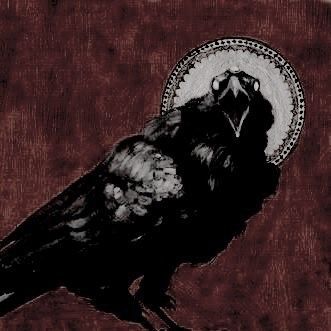

𝑒ND
getting rowan in front of the camera to spill it all was easy. too easy. she then proceeded to hold us all hostage and refused to leave till she got everything out. i hope you enjoyed our suffering that allowed us to make this simplified version.
she invites... @angelic-daiquiri @wonsters @viperrshifts (no pressure ofc!!)
,,burn book guide!
< page 6 | next page >
#row's grove#jtsburnbookevent 💋#shiftblr#reality shifter#reality shifting#shifting#shifting community#reality shift#shifting antis dni#shifting blog#desired reality#shifters#shifting consciousness#shifting realities#shifting reality#shifting motivation#anti shifters dni
61 notes
·
View notes
Note
im curious what ur thoughts on bliss was? i remember her inclusion was super controversial back when cn heavily promoted her intro episode as the "4th powerpuff girl"
my thoughts on bliss:
literally everything about her makes it so obvious they just wanted another powerpuff to sell merch of. even her being a teenager, i am almost positive that was specifically bc they saw how popular the clipsville teen designs were as annoying peoples pfps, but they simplified her body to the point it looks ugly. id like to say it was just to be easier on the animators, but considering the ms bellum and ms keane situations it is NOT looking good
back on bliss specifically: they made her body basically the standard powerpuff body, just taller and with massive hips, which is jarring not only because she looks just like her 5 year old sisters but because the black girl is the only one with emphasis on her curves. and people more qualified than me have said it before MANY times but its clear the creators only thoughts were "we should add a black powerpuff for diversity" without realising how making the black girl the unstable one who needed to be isolated for the good of society maybe didnt have the best optics (which is a common trend with buttercup fanart too but thats a separate issue. youd just hope theyd have learned their lesson by 2016. or at least by the time they were making cw...)
for writing, a lot of bliss' faults on a conceptual level link back to the character assassination of the professor. in 98 he was a well meaning and competent father who, while he made mistakes sometimes (there are. Several Episodes where he gets a new interest and starts neglecting his 5 y/o daughters 😭) he loved his children and would never do anything to hurt them. in 2016 he locked bubbles and buttercup in a hot car for hours because he was mad at blossom. there are several occasions where he cant tell them apart. LOOK AT THIS CLIP
they made the professor go from a good dad who loved his daughters to, and i realise this sounds oversensitive, actually abusive 😭 then when you get to the bliss episodes he gets 100x worse. the only reason he tried to make a child in the first place, wasnt because he wanted to be a dad or even to make the world a better place, it was because he wanted to one up another scientist who made a super child. from day one the professor didnt care about his kids, he saw them as a science experiment, as trophies, as his ticket to fame. they made him dick hardly.
and the fact bliss is then shipped off to space and only seen a few times after is even worse! from the professors pov, he was finally reunited with his daughter he had spent TEN YEARS mourning, then immediately let her go to space alone to do a job that should have just been a one day thing, but then they just establish she stayed in space to fight aliens (which blossom then. doubts the existence of in a completely unrelated episode. bc this show is a fucking trainwreck). as if she hadnt missed her dad for a DECADE. and thats not even getting into a later episode where, after blossom clones herself twice, professor says hes happy "as long as the amount of daughters i have remains a prime number". HE THOUGHT HE HAD 3 (5) DAUGHTERS AND NOT 4 (6)! he already forgot about bliss! the writers forgot about bliss! because she was nothing but a cash grab to drum up hype! look weve got another powerpuff girl! theres four now! (shed actually be the 7th powerpuff girl (bunny, bullet, and princess), 8th if you count mojo in mr mojos rising, maybe even 9th if you count power prof, but the creators of this show clearly didnt care)
and obviously i dont need to get into how atrocious her design is

everything from her random cyan hair despite every other ppg having a natural hair colour, the fact her stockings became leggings, the way they dont understand the girls wear mary janes and they interpret the white as part of the shoe design instead of the gap that shows the socks underneath (more obvious in a shot in the ep where she gets her shoes knocked off), even her skin is a super ashy brown but thats not really a problem specific to her, everyone in this show is extremely pale with horrible colour palettes
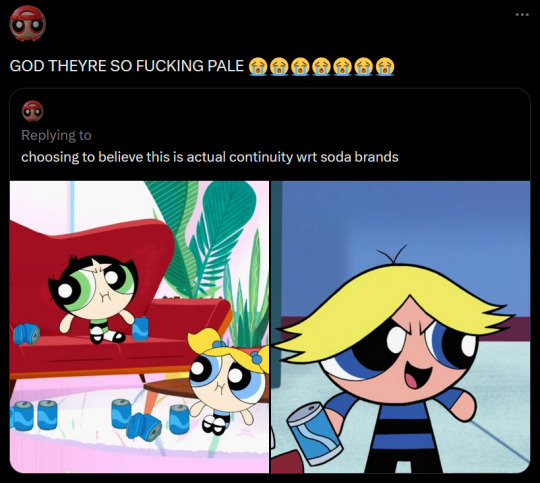
tldr: theres a reason my bliss rewrite/redesign changed basically everything about her
20 notes
·
View notes
Text
If this guy had just been a magician then we wouldn't be dealing with this shit
During one of his Social Link rank ups, Adachi implies some things about his career. I know, I know, he said "I became a cop because GUNS". But also: he's a dumbass.
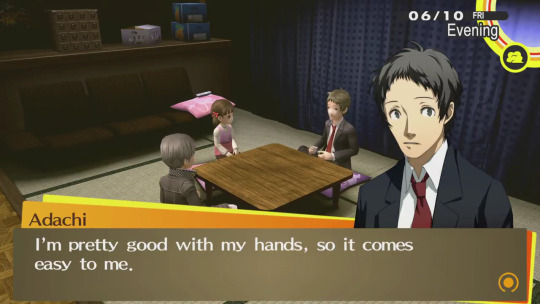
Thus far, the player has only seen Adachi being a bumbling moron running away from a little old lady at Junes. But we see a side of him we haven't seen before: It turns out that he has sleight of hand and he's quite good at performing magic tricks.
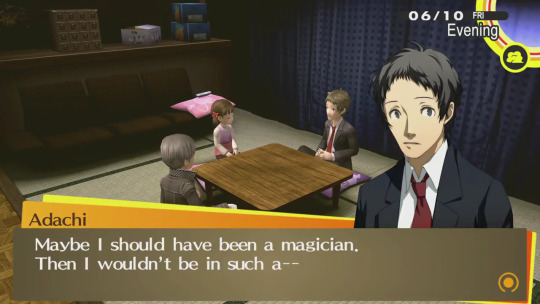
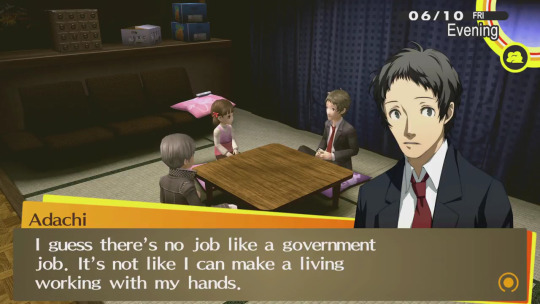
He doesn't think he could have made a living if he had gone into a profession working with his hands, even if he does demonstrate that he's good at it. He does acknowledge that his life might have been different. And when fiction does things like this, we in the audience know that the unspoken implication is that he would be a lot happier this way.
Adachi doesn't exactly try to hide how much he hates his life. But, at the same time, it's not like he tries to do much to change it. Part of it we see in his rank 6 social link when he talks about how "I'm lonely, but it's easier that way". But another part of it is that by being a police officer instead of a magician or something else, he gets to work at a government job. Job security certainly contributes to one's quality of life.
But I think there is something else worth noting about this, and it's based entirely off the year Adachi was born - 1984. (Insert the "literally 1984" calendar meme image here.)
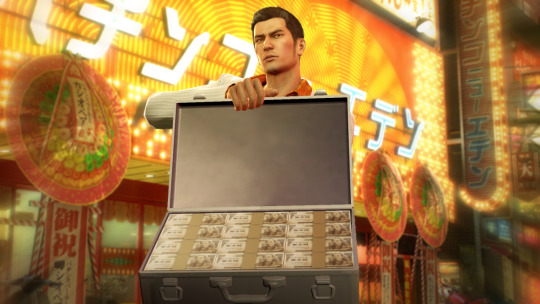
Adachi was born when Japan's economy was flourishing and the Yen was quite strong. Based on the timing, I think his parents had a kid under the assumption that, "Japan is prosperous, the Yen is powerful, things are great, everyone has money, or other valuable assets (stock/land)". If you've played Yakuza 0, this might vaguely sound familiar when it comes to Kiryu's story and his adventures in real estate.
This is a hilariously bad and overly simplified explanation, but it wasn't until the year after Adachi was born when the country and the bank began having economic issues. This eventually lead to the big blow up in the early 90s, stock and real estate nosedived, and the whole country went into a period of economic stagnation called the Lost Decades.
During Japan's period of growth, the country was seen as a powerhouse. My dad remembers when Japanese tourists were traveling all over due to strong yen - really a reversal of how it is now with people flocking to Japan due to how weak it is. People there would get a job and be set for life. While this was thanks to their economy and the assumption that "Wow, we have a lot of $$ in land and/or stocks, things are great", the "hired for life" thing can also be seen as being tied to Japanese labor laws. This changed after the economy exploded, and some companies began taking on temp workers who had less rights and less protections.
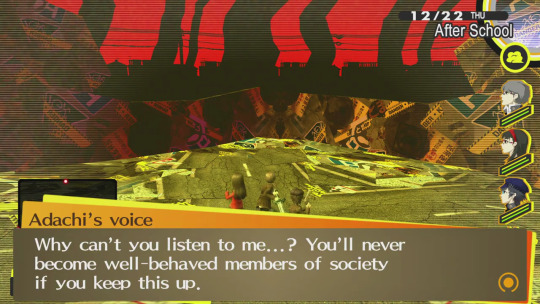
If you start to compare Adachi's situation and birth year to the main cast, it's really no wonder they make him so damn mad and frustrated lol.
Yukiko and Kanji can inherit their family businesses. Their families aren't wealthy, but they have stable businesses they operate out of their family homes. They can inherit both land and jobs.
In Yukiko's Social Link, she talks about getting licensed as an interior coordinator as a backup in case the ryokan doesn't work out... Hm, I think learning that she even has options would piss Adachi off further lol.
Naoto I am under the impression is doing well since she already has a career as a detective, plus the backing of her grandfather.
Yosuke's family doesn't own Junes, but his dad is the manager at the Inaba store, and nepotism is a thing. But it seems that he too has options, as in Ultimax, he's going to cram school so he can go to university.
Rise already has a career. Unfortunately, it's part of Japan's terrible and exploitive idol industry.
Even Marie has a career, it seems.
One can assume that if Adachi's parents got on his ass if his grades dropped, then Adachi does not stand to inherit something from his parents (or perhaps their assets lost value?), nor is he already successful.
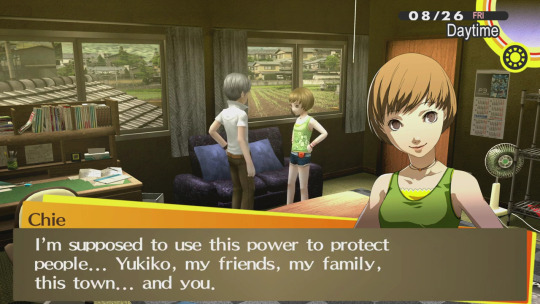
Chie feels like the outlier here. From what we know about her, her parents don't have a business she can inherit, no famous grandfather, she's not a popular idol, and she doesn't have Main Character privilege. We also know from her Social Link that she wants to become an officer like Adachi.
Really, I think Adachi is too young to have grown up on promises of some kind of prosperous future thanks to Japan's strong economy, merely to have the rug pulled out from under him and have his dreams crushed in 1991 (he'd only be 7, after all). So where Chie might optimistically see the ability to help and protect people as an officer, Adachi might see stability and survival because of his parents and how they raised him and the economic situation.
"Don't be a magician, get a secure job" is something our parents would tell us in the west too, so maybe it doesn't seem that special or related to their economic situation at all. Pretty sure his folks would say it to him even if he was born some 10-15 years earlier. But I think it does help illustrate why he would pick security (or why his parents picked security for him), his failure case (have fun being a replaceable temp worker while waiting for your big break as a magician), and what some of his ire towards the Investigation Team is about (he had to study; why do they get to go kill god after school???). In some ways, he feels like an American millennial whose life was affected by economic circumstance, but everything that comes out of his mouth makes him sound a boomer lol. Get off my dungeon lawn, you damn kids.
52 notes
·
View notes
Text








Photos of a bronze armillary sphere with three layers of rotating rings on an equatorial set up. The sphere is supported by three legs in a row, all decorated with detailed ornamentation and dragon figures. The text on the granite base is in Slovene and Mandarin Chinese (translation and originals under read more↓).
The astronomical instrument (an equatorial armillary sphere) that was unveiled on 6 February 2024 in front of the Archives of the Republic of Slovenia in Ljubljana – facing the location of the old Jesuit college, where its conceptor first received his education – is a full-scale replica of the original, finished in 1754, still in place at the Beijing Ancient Observatory in China.
Ferdinand Avguštin Haller von Hallerstein, known also by his Chinese name Liú Sōnglíng (劉松齡; simplified: 刘松龄) was born in 1703, received Jesuit education in Ljubljana, Vienna and Graz and arrived in Beijing in 1739 as a missionary, set to work at the Imperial Astronomical Bureau (which had been run by the Jesuits since 1669). In 1746 he succeeded the office of the head of the bureau and ran it until his death in 1774 – longer than any of his predecessors. He died soon after a stroke he reportedly suffered upon hearing the news that the Pope had disbanded the Jesuit order (in 1773; that suppression was later lifted in 1814).
Beside the astronomical work (published as Observationes astronomicæ), he also worked as a cartographer (creating a map of Macao and its environs, of Manchuria and contributing to the Jesuit Atlas of China) and is noted for making the first exact estimate of the Chinese population (calculated to have been 196,837,977 in 1760 and 198,214,624 in 1761).


Astronomical instruments at the Beijing Ancient Observatory. Hallerstein's armillary sphere is in the foreground. {x} • {x}
The armillary sphere is one of a kind, combining Chinese and European astronomical knowledge as requested by the Qiánlóng Emperor (乾隆帝), who wanted to both honor the tradition of his ancestors and make the instrument as accurate as possible by the standards of the time. The instrument is 3.7 m long, 2.1 m wide and 3.3 m high. It is made of bronze and weighs more than 5 tons. Its replica is made of the same material and is of the same size, built in China using 3D-scanning technology and later transported to Slovenia, and is also fully functional. The design of the original instrument started in 1744 and when it was finished 10 years later, it was considered the pinnacle of Chinese astronomical science as well as artistic craftsmanship.
The Astronomical Instrument was conceived by Augustin Ferdinand Hallerstein (*1703 Ljubljana, †1774 Beijing), a Slovene Jesuit, astronomer, mathematician, cartographer and diplomat, during the time he lived in Qing China. The original stands at the Beijing Ancient Obsevatory. The replica of the instrument is a gift of the Embassy of the People's Republic of China as an incentive for the continuation of cultural exchange between Slovenia and China. Urban Municipality of Ljubljana, 2022
Zvezdni opazovalnik je v času dinastije Qing med svojim življenjem na Kitajskem zasnoval Auguštin Ferdinand Hallerstein (Ljubljana 1703–1774 Peking), slovenski jezuit, astronom, matematik, kartograf in diplomat. Izvirnik stoji na Starem pekinškem astronomskem observatoriju. Repliko opazovalnika je podarilo Veleposlaništvo LR Kitajske kot spodbudo za nadaljevanje kulturnih stikov med Slovenijo in Kitajsko. Mestna občina Ljubljana, 2022
玑衡抚辰仪 值此中华人民共和国同斯洛文尼亚共和国建交30周年,中国驻斯洛文尼亚大使馆和北京天文馆特赠天文观测仪器玑衡抚辰仪同比例复制品,以兹纪念。玑衡抚辰仪由斯洛文尼亚人刘松龄 (1703–1774) 在华担任清朝钦天监监正期间主持制造,原件陈列于北京古观象台。 二〇二二年
(for the latter, thanks go to this anon!!)
#j#slovenia#china#hallerstein#ferdinand augustin von hallerstein#liu songling#ljubljana#beijing ancient observatory#history of astronomy#etc etc#hist#astro#my photos#(except for the last two)#i didn't know about him dying bc of hearing about jesuits being suppressed before writing this post and that's so funny tbh#common christian L#also i heard the instrument described as being built using the european heliocentric principles combined with chinese geocentric ones#but i didn't use that because 1) it's misleading wrt the chinese who were not opposed to the heliocentric model because they were not reall#using a geocentric model either#they were more confused by europeans first arguing for one and later the other#so a description saying that it was built using the european heliocentric principles with a traditional chinese equatorial base is better i#but then comes 2) the pope only allowed copernican thought to be taught in 1757 – which is 3 years after the instrument was finished and#13 years after its design started#so idk if jesuits just ignored that (which is possible! even likely ig) and that was one of the factors in them getting disbanded ?#or if people are just describing it wrong#because those two facts (the timing of the instrument and the pope's heliocentrism) are never discussed together from what i've read#in any case... i just thing it's cool Ꜣ)
16 notes
·
View notes
Text
Affogato has an appointment tomorrow morning most likely for euthanasia. He has been with me since he was 6 months old and is just shy of 2 years now. He is a fantastic little dude and came from my very first rat intake at Tiny Whiskers along with his brothers Tiramisu and Oreo Crumble.
Oreo Crumble was let go not long ago and I feel that I waited too long for him. I really don't want that for Affogato.
My vet was at my house a few weeks ago and predicted Affogato would not have long left as he was starting to lose condition despite attempts to increase his caloric intake plus downsizing and simplifying the enclosure.
He has had chronic respiratory problems pretty much his entire life but he is losing weight and only really comes out for his porridge or a drink of water. The rest of the time he sits in a hide, almost the entire day. He used to be incredibly active and playful and used the entirety of his quad critter nation and now he struggles to navigate a single.
Tiramisu and my other senior boy Bandit will miss him a lot, and honestly probably won't be far behind him. They're old and they're tired.
15 notes
·
View notes
Text
Apr 11, Xi'an, China, Beilin Museum (Stele Forest):
Continuing from the previous post about the museum... I have a LOT of pictures from this trip to Xi'an, almost 900 pictures total. For the sake of brevity, I will not post all of them.
Jingyun Bell/景云钟:
The Jingyun bell is a giant bronze bell cast in 711 AD (Tang dynasty), this bell was originally inside the Bell Tower of Xi'an/西安钟楼, and bear the inscription written by Emperor Ruizong of Tang/唐睿宗 (full name Li Dan/李旦). This bell is 2.47 m tall (~8.1 ft), has a circumference of 4.86 m (~15.9 ft), has a diameter (at opening) of 1.65 m (~5.4 ft), and weighs 6 metric tons (~6.6 US tons).
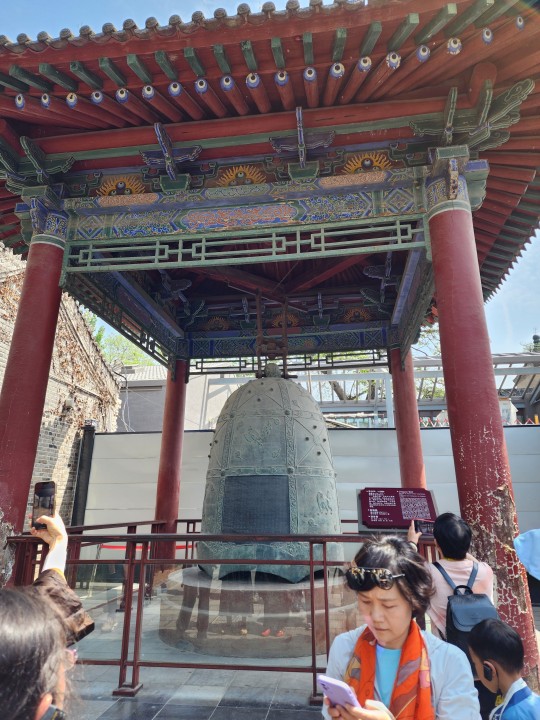
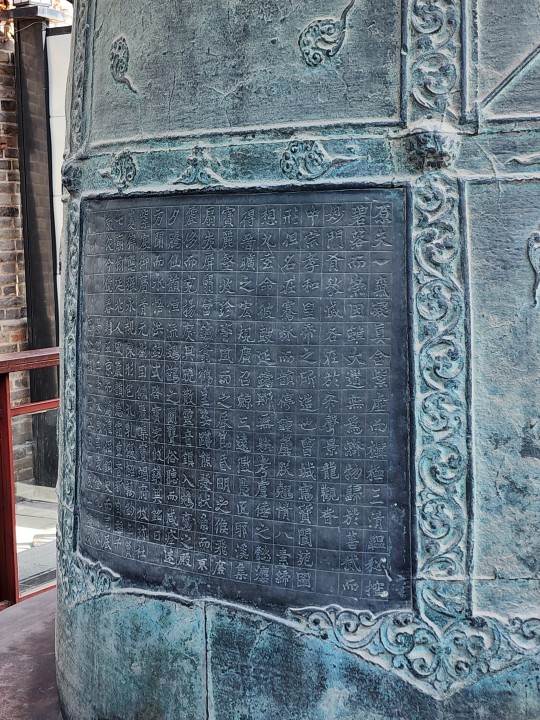
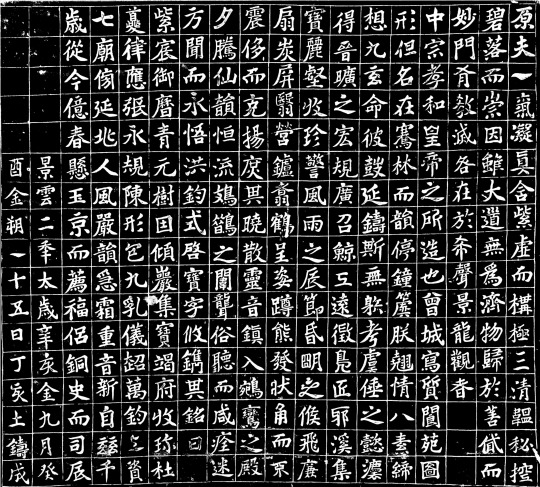
Fun fact about Emperor Ruizong of Tang Li Dan: apparently he has the nickname of "六位帝皇丸", or "Six Emperors Wan". "六味地黄丸" is the name of a prescription in traditional Chinese medicine, but here it's used as a pun. This is because Li Dan himself had been emperor twice, his father Li Zhi/李治 was the emperor (Emperor Gaozong of Tang/唐高宗) before him , his mother Wu Zetian/武则天 made him cede the throne to her and became emperor after his first reign (Emperor Zetian Dasheng/则天大圣皇帝), his older brother Li Xian/李显 was an emperor (Emperor Zhongzong of Tang/唐中宗), and finally after his second reign, he ceded the throne to his son Li Longji/李隆基 (Emperor Xuanzong of Tang/唐玄宗). So that's the 6 emperors, and they all came from himself and his immediate family.
Just in case that was confusing, here's his family tree:
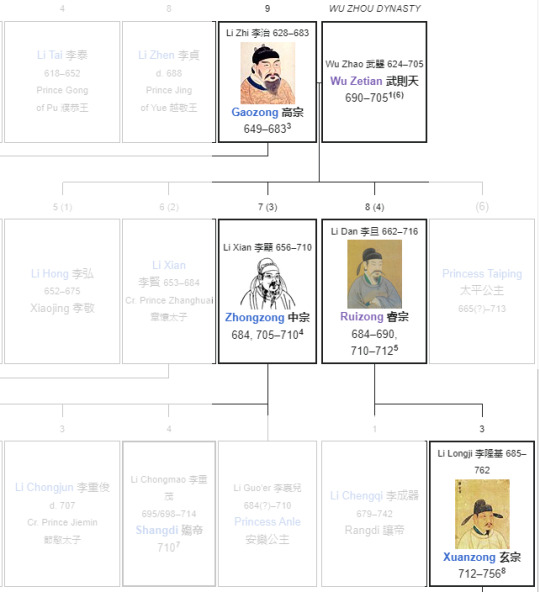
One more fun fact about the bell itself: it provided the bell sound sample heard at midnight in CCTV New Year's Gala every year. The bell itself probably won't be sounded anymore for conservation purposes--it is over 1300 years old at this point. The bell currently inside the Bell Tower of Xi'an is a replica.
Classic of Filial Piety Set Upon Stone/石台孝经:
This stele is also among the most famous in the Beilin Museum, as it combines the calligraphy work of two emperors of Tang dynasty, Emperor Xuanzong of Tang/唐玄宗 Li Longji/李隆基, and his son, Emperor Suzong of Tang/唐肃宗 Li Heng/李亨, and also has excellent examples of 4 different scripts. Specifically, Li Longji wrote the Classic of Filial Piety/孝经 (a Confucian classic text) and annotated it in lishu/clerical script/隶书, then added comments in xingshu/semi-cursive script/行书. Li Heng wrote the title in zhuanshu/seal script/篆书 (see picture of the actual stele below), and a memorial written in kaishu/regular script/楷书 by Imperial College Chief/国子监祭酒 Li Qigu/李齐古.
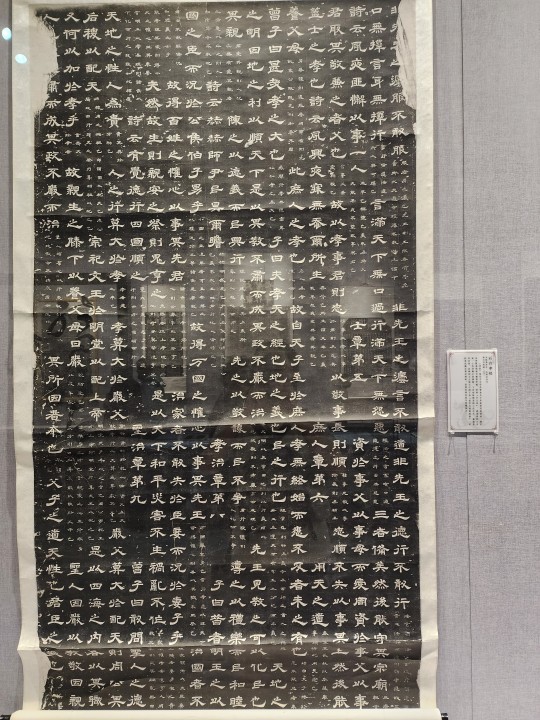
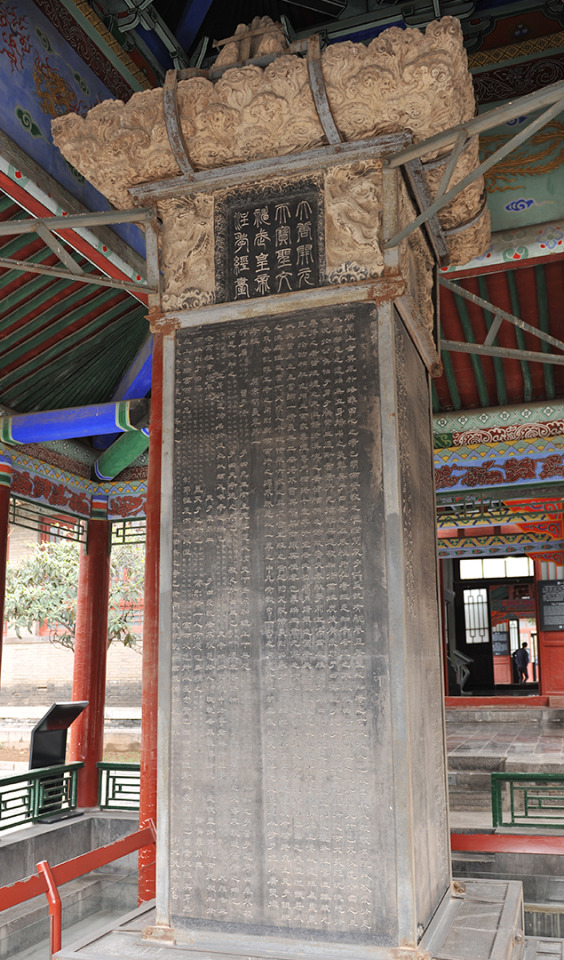
Since the stele actually has inscriptions on all four sides, here's the complete rubbing:
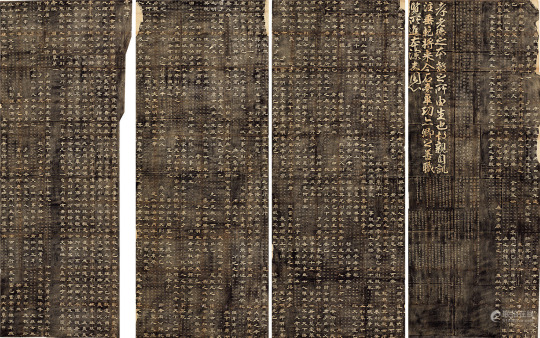
Here's the pavilion over the stele, picture from Wikipedia. The bian'e/匾额 (can be understood as a sign) says "stele forest"/碑林 (read from right to left), and was by Lin Zexu/林则徐 (1785 - 1850). The exact reason why 碑 is missing a stroke at the top is unclear, but one thing is certain: that was one of the correct ways to write the character. It's just that modern standardized systems of written Chinese (both Simplified and Traditional) only accept 碑 as the correct form.
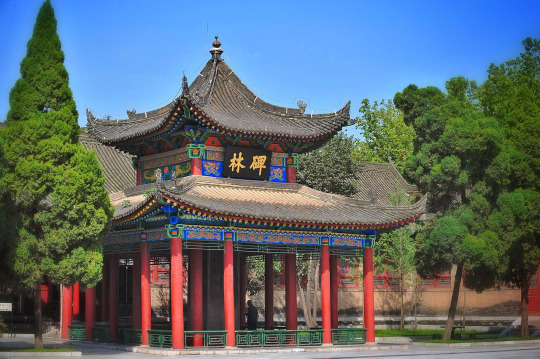
Cao Quan Stele/曹全碑:
One of the most famous steles in the museum. This stele, which praised Cao Quan's accomplishments, was written by Wang Chang/王敞 and was erected in 185 AD (late Eastern Han dynasty). It is important for two reasons, first is because it represents lishu/clerical script/隶书 at its full maturity by the end of Eastern Han dynasty. The second reason is because it provides a great source for scholars studying the history of that time, particularly with regard to the Yellow Turban Rebellion.
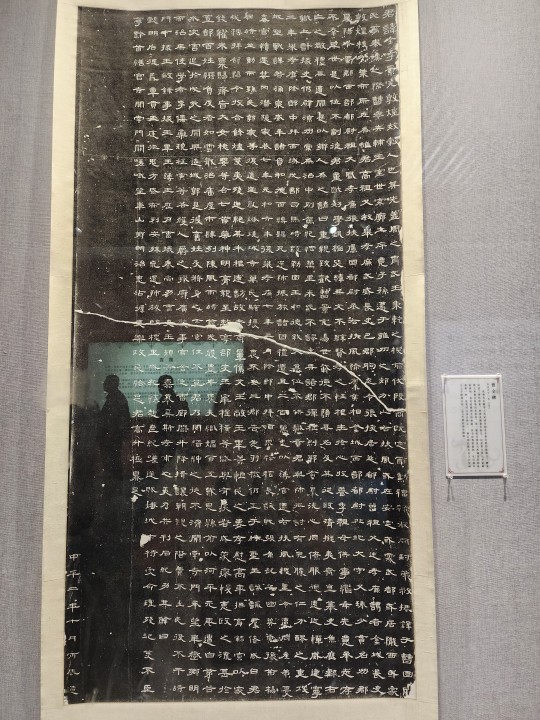
A closeup at the calligraphy:
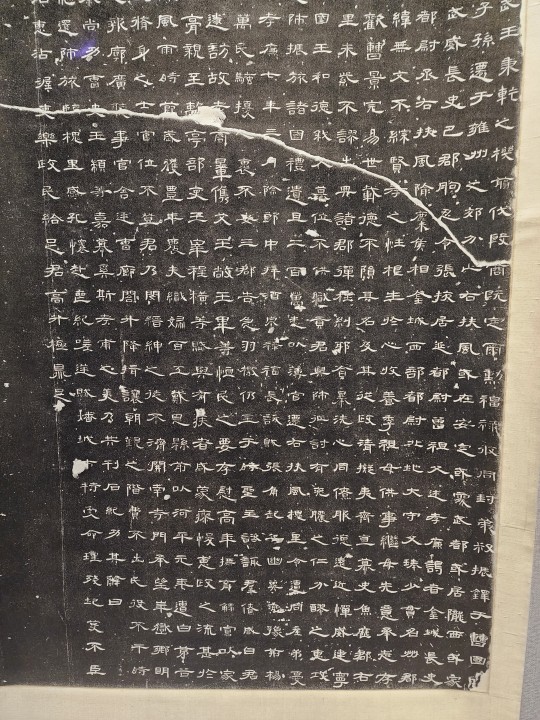
Li Mountain Hot Springs Poem/骊山温泉诗:
This one isn't particularly famous, but it is one of my personal favorites from the exhibition. The calligraphy was by Prince Guo/果亲王 of Qing dynasty (full name Aisin Gioro Yunli/爱新觉罗·允礼) in 1735, and is in the xingshu/semi-cursive/行书 script.
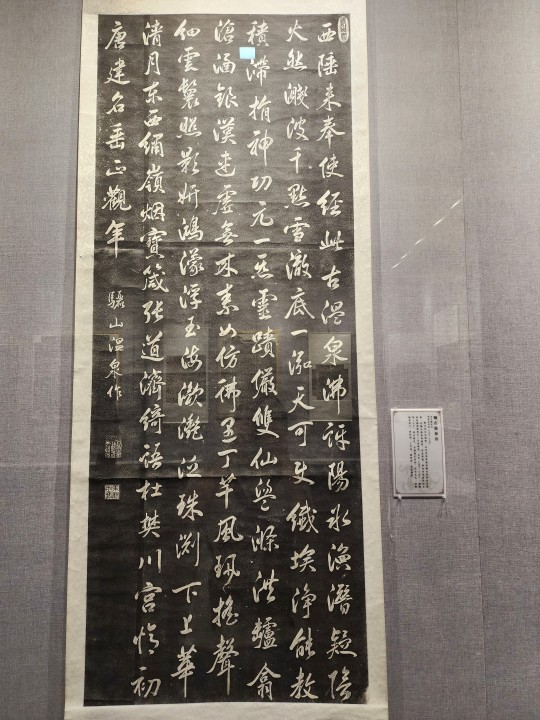
Emperor's Calligraphy Work in Daguan Period/大观圣作之碑:
This stele is actually not part of the Beilin Museum's collection, since it's currently located in Zhaozhou, Hebei, China. I thought I should include it here, because the writing is in a script that I've never really talked about before, which is the shoujinti/"slim gold script"/瘦金体. It's a variation of kaishu/regular script/楷书 that's invented by Emperor Huizong of Song/宋徽宗 Zhao Ji/赵佶, who is the calligrapher here, hence the title.
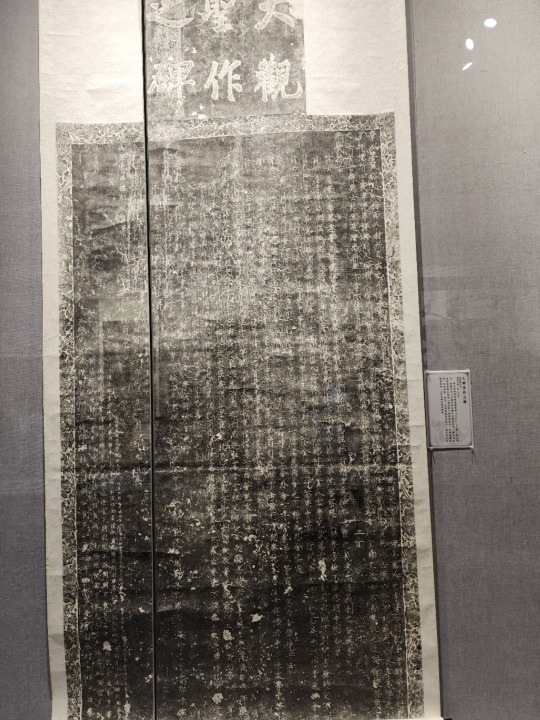
A closeup of the calligraphy:
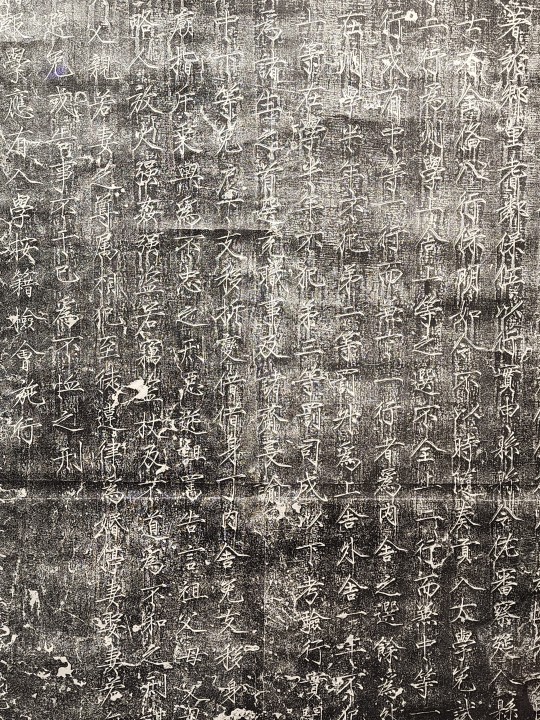
Stele of an Imperial Edict/加圣号诏碑:
By Zhao Shiyan/赵世延 in 1313 (Yuan dynasty). The content is an imperial edict in 1307 that posthumously bestowed the title of "Great Completer, Ultimate Sage and Exalted King of Culture"/大成至圣文宣王 upon Confucius. The purpose of this picture is just to show what the bigger steles really look like, as ink rubbings definitely don't do them justice. The top is decorated with two carved dragons, and the stele is mounted on a stone bixi/赑屃, one of the 9 sons of the loong that has remarkable strength and looks like a turtle (with teeth).
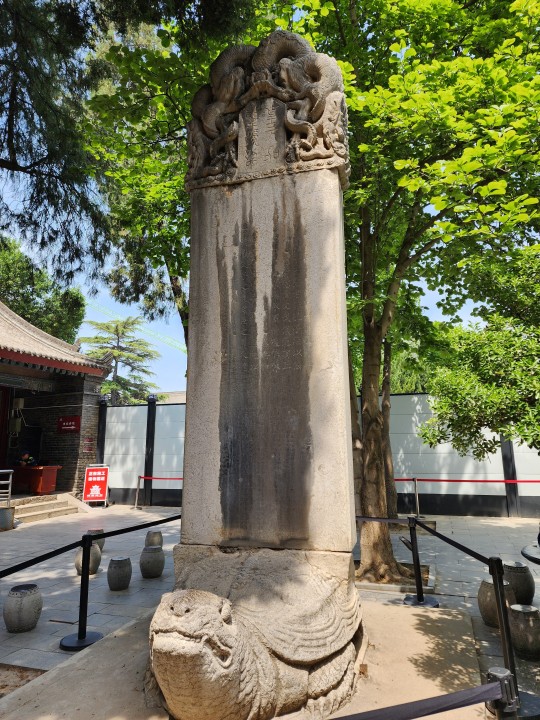
And finally a pagoda tree/槐树 outside the museum that is 1100 years old (planted at around the end of Tang dynasty):
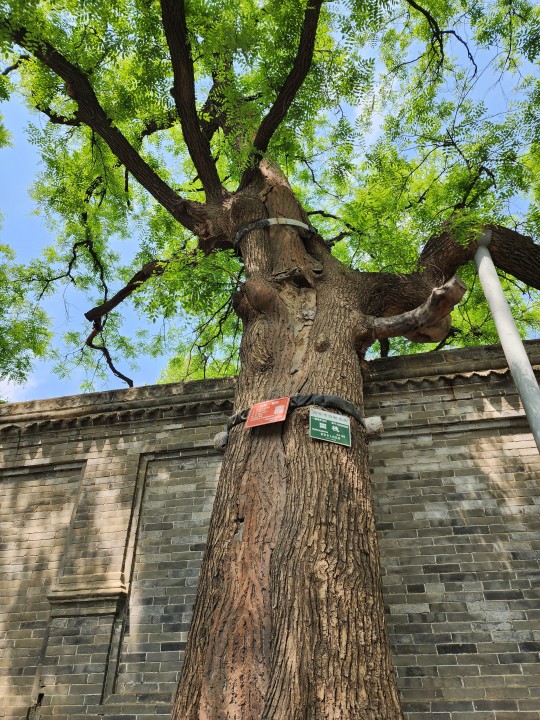
#2024 china#china#xi'an#beilin museum#stele forest#chinese culture#chinese history#chinese calligraphy#calligraphy#chinese art#edited since I screwed up the date of the pictures....I went to beilin museum on the 11th not the 10th :P my bad
25 notes
·
View notes
Text
Roundabout
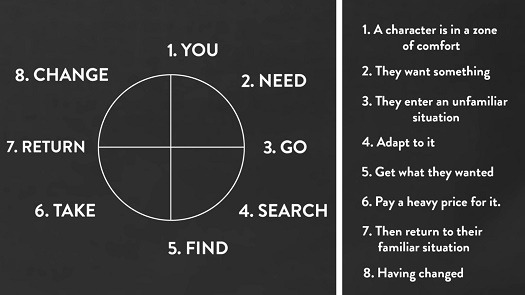
I watched CJ the X's video about Rick and Morty, mainly because I kept seeing people screencap the parts about perfectionism near the beginning. Well, I thought I should see it for myself, and then I wound up getting pulled into the "Story Circle" concept used by series co-creator Dan Harmon.
This may be old news to a lot of people-- in fact, I'm sure it is, because Harmon admits that this is heavily based on the monomyth concept popularized by Joseph Campbell. I've never fully appreciated the "Hero's Journey" idea before, but I think Harmon has refined it by simplifying the names of the steps. "Atonement with the Father" just becomes "Take", and that's a lot easier for me to grasp. Campbell probably never meant to suggest that every story features a literal "atonement with the father", but his work involved identifying common elements in story structure, so I'm sure he had trouble coming up with fitting names for everything.
Harmon's circle might be a little too simplified, since there's a lot to unpack in the word "Take", but his model is focused on making a formula to write new stories, as opposed to comparative mythology. What I like a lot about the Story Circle is that Harmon insists that it's not a rule that must be learned and followed. Rather, it's an observation of something all humans do when they tell stories, whether they realize it or not. But sometimes it can be helpful to be made aware of the pattern, like checking a map even when you're familiar with the route.
It can be fun, although probably distracting, to apply the circle to existing works. The Star Wars movies used Campbell's monomyth as a blueprint, so that's probably too easy. But it can also be used on individual scenes too. Luke(1) falls down a trap door and now he has to find a way back out (2) before the rancor eats him (3). He manages to avoid being eaten using a bone and some nooks and crannies in the pit (4) but at last he finds a door out of the dungeon, except it's locked, leaving him cornered (5). But he manages to drop a heavy gate on the rancor as it approaches him, which kills it (6). The bad guys then open the door to bring him back to Jabba (7), who now prepares to feed him to an even worse monster outside (8).
And that probably sets up the next cycle in the movie, where Luke saves everyone from the next monster, and so on. I think at long last I understand why these kinds of story structures are presented as "circles" or cycles". You don't have to do multiple laps, but the structure allows you to do so, and acknowledges that multiple cycles can also form a larger circle, and so on.
With episodic television series, the final step, change, often means reverting to the status quo. There's a M*A*S*H episode where Radar tries to become a serious writer, and he keeps trying to inject his army reports with purple prose, until finally Hawkeye explains to him that he has to use his own words and stop trying to imitate what he thinks the "pros" use. So Radar does learn a lesson, but the lesson basically puts an end to the weird dialogue he was using the whole episode and puts him back to normal. The Korean War doesn't end, and Colonel Potter doesn't die, and Klinger still wears dresses, but the structure is still followed and sets up the next cycle.
I can see how this is very useful in a writers' room for a television show, especially one like Rick and Morty, where the characters seem to be capable of almost anything. It probably helps to take stray ideas like "Rick turns himself into a pickle!" and run that through a formula to make sure you can get a working script out of the gag.
Anyway, I'm currently trying to use it to flesh out some ideas for my fanfic, since I have a lot of story beats I want to accomplish, but I don't have much to connect them together. Using the Story Circle seems to be helping me figure out which pieces I'm missing, so maybe this will compensate for all those years where I could just use DBZ Episode 66 and Xenoverse 1 as loose outlines that I could follow. This fall, I gotta build my own story skeleton before I can fill it in, and the clock is ticking...
13 notes
·
View notes
Text
Máni: Man in the Moon Dwarf Planet ~ 15 June 2025
Máni: Man in the Moon Dwarf Planet ~ 15 June 2025, Philip Sedgwick
Since the naming of Máni is breaking news (as if we’ve not had any of that lately), I decided to move up this week’s SkyScraping post. The week of 23 June, we should be back to a regularly scheduled post.
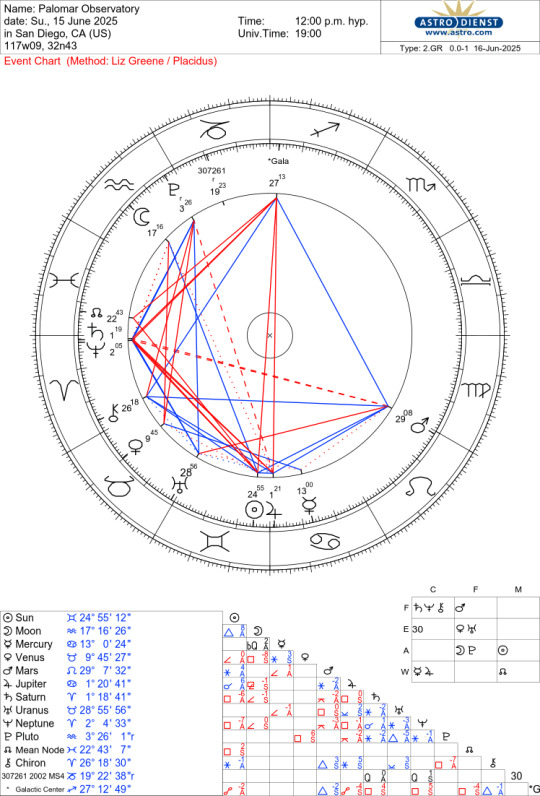
Funny how it goes out there at the currently perceived edge of the solar system. While Chad Trujillo and Michael Brown conducted a search for Pluto-sized Kuiper belt objects at Palomar Observatory, on 18 June 2002, they encountered 2002 MS4. Once the orbit’s orbital elements could be confirmed, the object became minor solar system body 307261. And this past week, this object became known as Máni. Currently, this likely dwarf planet stands at 19 Capricorn 23 on your friendly ecliptical dial.
Likely dwarf planet, is it? Máni's mean diameter figures to be 796 km (495 mi), which places it between the diameters of the dwarf planet Ceres and proto planet Vesta. Máni is the 10th largest known TNO, to date. If Charon gets thrown into the mix, then it drops to number eleven on the largest KBO chart.
Máni‘s name derives from the Old Norse and means "Moon.” According to Germanic mythology, Máni, is the brother of the personified sun, Sól (I am not sure what personified sun suggests). Scholars speculate that he refers to the Northern European notion of the Man in the Moon.
Máni’s eccentricity of 0.1453 stands in the moderate range; its inclination is 17.7° - not particularly spectacular. With a rotation period of 14.251 hours, Máni’s revolution about the Sun runs 269.48 years, and creates the assumption that this object is a classical cubewano. However, Máni possesses a diverse and wide-ranging topography. On its surface, Máni sports a mountain that is 25 km high contrasted with a crater estimated to be 45 km deep, current assessments are entirely speculative.
What does Máni mean interpretively? Máni's north node slices the ecliptic at 6 Scorpio 13. His perihelion is 11 Gemini 04. An amalgamation of these factors notes a perceived urgency that pushes communication out there, ready or not. Such discourse renderings do well to ensure the messaging that resonates at the core interval level. The orbital elements combined establish a superficiality-free zone. Evocative is where it happens. Blow a person’s mind so they feel through and through. Exploit emotional attachments to create logical perspectives intending to simplify muddied feelings.
Given the communication conjuring innate within Máni, expect that matters involving AI are strongly impacted. An innate skill for conjuring lore, storytelling especially emotionally evocative or scary tales dominates ones skill set with Máni prominent. As well, this body seems to enjoy pranking, and is simultaneously susceptible to catfishing (online impersonation). Máni shows up in a time of rampant online fraud and fakes, to demand each person trust their absolute instincts about conditions and challenges they face. It may be more than you think. It might also be a wisp of what is feared.
More to come from the Kuiper Belt soon... when, who knows? We do know that those searching the skies are relentless with their efforts in a good way. Incidentally, on 15 May, the SkyScraping dealt with a Planet 9 update. Mike Brown, co-discoverer of Máni and astronomer largely responsible for Pluto’s planetary status demotion, does not believe that the crew that discovered Telisto found Planet 9. At least it’s not the object he’s hound dogging out there in space. This reminds me of the amazing stories surrounding modern planet discovery. Modern being anything from Uranus onward. In each discovery instance since Uranus, there has been political intrigue, something less than ideal human behavior, funding issues, squabbles over naming the object and insane competitiveness.
If you want to be the first kid on the block to have the latest Kuiper Belt news, hop onboard with the KBGASP program. Those in the program have already received an ephemeris for the new dwarf planet, updated orbital data sheet, and a set of keywords including those for interpreting Máni.
A reminder that the KBGASP program if engaged before 4 July, also includes the option of adding a one-hour consultation for a discounted rate of $399.99. And this permits you to order a Galactic Report for nearly half off (additional $7). Please e-mail for payment options.
Standard consultations and more are available by using the links following:
One Stop Shopping Kuiper Belt / Galactic Study Course Order Form Astrological Texts
METEORIC the Movie on Vimeo ZAP! on Vimeo
3 notes
·
View notes
Text

The 18th World Chess Champion is 18 Years Old!
Congratulations to the new classical world chess champion: Gukesh Dommaraju. The 18 year-old has become The youngest Undisputed Classical World Chess Champion in history. An unprecedented accomplishment! He leads a group of young players born after the turn of the millennium who are now making chess's world stage their own.
To become The World Champion, Gukesh beat 17th World Champion Ding Liren, at one time the world #3 for years and considered one of the top players in the world, he emerged from the pandemic struggling to replicate his earlier performances. Ding put up a tough fight, and did better than many expected, but chess is unforgiving and a mistake late in the last game of the match has cost him the title.
The young champion Gukesh is the second player from India to become the undisputed world champion after the 15th world champion Viswanathan Anand.
Ramblings below the cut ✂️
In chess there are two main mountains: The classical world championship and the top spot on the rating list. Gukesh for himself, for India and for the new generation has claimed the world championship. Gukesh sits at #5 in the world on the rating list with a rating of 2776.8. This puts him behind World #4 Arjun Erigaisi, another Indian prodigy, age 21 who has rocketed up the rating lists in the last year earning a rating 2800.6, 15th highest ever!
Gukesh and Arjun are joined by Nodirbek Abdusattorov age 20, from Uzbekistan world#6 (2767.6) and Alireza Firouzja the 21 year old, world #7 (2763), originally from Iran now residing in France and identifying as French after leaving Iran due to their policy of not letting their players play against those from Israel. Alireza Firouzja is worth particular note as up until today he was considered the top of the new generation. Dubbed the prince of chess. Alireza who has so far peaked at #2 in the world, with a rating of 2804 (back in late 2021) and notably has the highest ability of the new generation at speed chess. Which has emerged as a new arena of play, rivaling that of the classical time format. Alireza has struggled with high pressure events, which has been the seperating factor between him and the Indian stars.
Ahead of our young rising stars are
World #3
37 year old Hikaru Nakamura (current: 2802, peak: 2816)
A top 10 player for many years, Hikaru would pivot to twich and youtube, and speed chess events for a few years and he would emerge as perhaps the most popular chess player in the current media landscape. This gave him the security to return to Classical Chess and surge to the top 2 or 3 where he has stayed for quite some time.
World #2 Fabiano Caruana (Current: 2803.4, peak: 2844)
The quiet 32 year old American has had a legendary career so far. He lost the 2018 world championship (the first one I watched live!) in the tiebreak portion and has since not had a chance to compete for the title again. In terms of rating lists and tournament performance Fabiano Caruana is the definitive #2 player of the past 15 years.
Lastly of course, is the World #1
Magnus Carlsen
The 34 year old Norwegian, currently rated 2831, peak rating of 2882
From 2013-2023 he was The World Champion, and has been the #1 player on the rating list since 2011, not once leaving that spot since. During the 2010's Magnus would come and go with speed chess, almost always winning, like usual, when he did play. He pivoted to online speed chess events during the pandemic and has more or less elected to stick with that. Magnus vacated the world championship in 2023 after deciding he was done being bored and frustrated with a format he had complained about for a decade. Magnus has more or less retired from classical play, playing only the occasional event and focusing on other endeavors and speed chess events. To simplify a bit, Magnus has basically run out of things to do in chess so he's doing other things and playing chess when he feels like it.
When Magnus vacated the title he did so after learning his challenger would be Ian Nepomniachtchi one of the best in the world but someine Magnus had definitively beat in in the 2022 World Championship. Whats interesting is Magnus had said he'd defend the title if Alireza was the one who won the right to challenge him. Magnus has maintained a love for Alireza's playing style and high praise for his talent. Saying multiple times how much he enjoys watching him play and playing against him. Especially in speed chess. So of course, with Magnus commentating on the 2024 world title match, and Gukesh's win. Magnus' co-hosts have asked him if he's interested in trying to get a match with Gukesh and Magnus said no. Personally I think this stems more from Magnus just disliking the title format than anything else.
Still! That leaves interesting questions and contests to come! For the world champion, he wont need to defend his title until 2026. He'll be 20, and likely an even stronger player. But both his peers and his seniors,, especially Fabiano Caruana are challengers who will always pose a threat.
As for the rating list.
1,2&3 are all 30+
4,5,6&7 are all under 25
Its going to be very interesting to see when the kids pass the vets. Eventually it'll be interesting to see just how high these new players peak and the change they have on the game.
It'll be interesting to watch the battles they have with each other and the occasional battles they have with Magnus who remains the best in the world. Be it in speed chess or the occasional classical game.
#fide#chess.com#world chess championship#Gukesh Dommaraju#Gukesh#Ding Liren#arjun erigaisi#alireza firouzja#magnus carlsen#hikaru nakamura#fabiano caruana#ian nepomniachtchi#Nordibek Abdusattorov
8 notes
·
View notes
Note
HELLO, you made such an interesting point in the tags of my post:
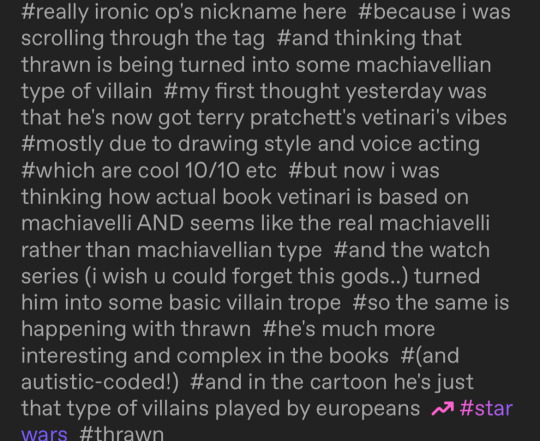
You know what’s funny? Is that Thrawn is really being turned into a “Machiavellian” type of villain, but what’s even funnier is that Machiavelli himself received this type of treatment. Now idk how much familiar you are with the 16th century author, but just know this: Machiavelli and “Machiavellian”, and whatever people can take from him, is heavily misunderstood (I actually really hate the use of the adjective, but perhaps that’s a story for another type). Now I know that Zahn wrote Thrawn based on a certain extent on the Machiavelli archetype (I remember reading it somewhere, pardon if I have no proofs), but I’m actually laughing hard thinking that as characters they are having the same treatment by popular media. Lemme explain: Machiavelli wrote the Principe not because “oh he cynic!1!🥶He mad!1🤬”. No. Machiavelli wrote what he wrote because he wanted to save Italy dalla Ruina, from its ruin. Machiavelli dreamed of a more compact and unified Italy. He had a vision and just as much as Thrawn, he wished to serve his people, Florence (in Thrawn’s case, the ascendancy) and Italy (which didn’t existed at the time).
And now, with Thrawn being reduced as you said in a villan without complex motifs, I can’t help but think how poetic is to be doomed to the same narrative as the figure who inspired your existence. Maybe this was planned all along, I don’t think so personally, but Thrawn is being oversimplified by Filoni the same way Machiavelli gets reduced as just a “pragmatic person” and “the ends justify the means” by everyone (don’t let me start on how wrong the quote is).
To sum up: Thrawn and Machiavellian are rhyming in the same direction in popular mainstream media.
This was my Ted talk, sorry in advance for possible writing mistakes, I just woke up✌️
Hiii! Thank you so much for the spontaneous Ted talk 😄😄 Your parallel between the Ascendancy and Florence+Italy is sooo on point, it blew my mind for a second. Now I have to delve deeper into it
Actually there was a period of time when I was really invested in this topic, I read his 10 letters, history of Florence +the Prince obviously and almost fell from a chair when they put him into Assassins Creed game, but now there're just small bits that I remember. Maybe it's time to refresh things
I didn't know that Zahn was actually inspired by Machiavelli. I'm new to this part of the fandom, so I haven't read anything about him or his working process, but after you mentioned it I'll take a note for the future. I must confess I learned who Thrawn was only during the Ahsoka show and due to the fandom. Like there were so many memes about him here on Tumblr, there's no way fans will hype some basic dude so much. And then my friend recommended the new trilogy
So yeah, it's such a pity that not 1, but 6 books of new material got completely ignored and the character simplified to what we've already seen so many times literally everywhere. You phrased it beautifully
I haven't read the old trilogy yet, heir to the empire, only know the plot in general, but I'm curious what exactly motivates Thrawn to rebuild the empire. And how the characterization of him differs between these trilogies. Is he mostly the same or did Zahn change the character after so many years like Terry Pratchett's Vetinari evolved from the very first version of the Patrician to his later works (I can't help comparing them after yesterday, though I hadn't done it before idk)
So yeaah... At least I'm happy that there're so many talented fans here and we can happily ignore whatever happens on the screen 🙃
#again thank you so much#im always happy to discuss our old blue man#even if i'm still going through the ascendancy trilogy#once i get my degree im so going to draw#and read#also im much closer now to getting him in star wars galaxy of heroes game#sooooon (in a year /j)#star wars#thrawn
26 notes
·
View notes
Text
Travellers on the Midnight Train
A fanfiction, in snippets.
Summary: Views through the eyes of SEEDS Mothership 5’s crew. Combo-platter of ‘98 and Trigun Maximum.
1. 2. 3. 4. 5. 6. 7. 8. 9. 10. 11. 12. 13. 14. 15. 16. 17. 18. 19. 20. 21. 22. 23. 24. 25.26. 27. 28. 29.30. 31. 32. 33. 34. 35. 36. 37. 38. 39. 40. FINAL.
17. Whalefalls
“Rowan! Rowaaaaan! Did you know about whalefalls?!” Vash was excited today and Rowan laughed. The twins were capering around him in one of the computer-rooms. Before he could even answer, Vash decided to explain his new obsession. “So, Rem read some books with us and showed us some videos and stuff and she explained how back on Earth, when whales died their bodies would drift to the bottom of the sea and feed all sorts of creatures that depended upon them! There were all kinds of crabs and amphipods that would even eat their BONES! And this would go on for years and years because whales were BIG! Didja ever see a whale back on Earth, Rowan? Did ya?” “I’m afraid not,” Rowan answered calmly. “I never set out to sea and most large cetaceans were extinct by the time the ships left.” “Aw….really?” Vash looked like he was on the verge of crying at this news. Knives crossed his arms. “All that stuff about marine snow was gross, anyway. Imagine being some deep sea fish in the dark eating the skin and poop of other creatures. Horrible!” “Do you think we will find whales on the planets we’re searching for?” Vash asked,” Or even out in space?” Rowan chuckled. “Probably not. The void of space isn’t particularly hospitiable to the formation of life and convergent evolution might generate something close to a whale, but it wouldn’t be the same thing.” Boy, were these kids growing up something quick! They were only a few months old and already looked like they were at least five. They spoke without lisps and used very mature words. It was almost like they had downloaded large swaths of information straight into their brains and were ready to go. He felt no need to simplify his speech around them because whenever he tried, the lighter-haired one would actively get mad. Rowan felt uncomfortable in the presence of that one’s “do you think we’re stupid?” glare. He answered any and all questions in the manner that he might speak to a colleague. The one with the slightly darker shade of blond was the most chatty - the most excited in asking questions. But they could be exhausting. “Where’s Rem?” Rowan asked, hoping for some small relief. “Sleeping,” Knives answered. “Yeah,” Vash concurred. “She said something about there not being enough coffee in the universe, whatever that means.” Rowan couldn’t help but crack a smile. “Do you want to go bother the Captain?” “Yeah!!!” came a shout in unison.
#trigun#trigun maximum#vash the stampede#millions knives#young vash#young nai#Project SEEDS#rowan (trigun)#travellers on the midnight train (fic)#trigun fanfiction
4 notes
·
View notes
Text
So over this past week I kept looking at my first sketch of Aiyana's outfit and I was kinda disappointed in it tbh. I walked right into what I didn't want it to look like. A sexy native american costume. Seriously, it gave "gift shop Indian" and I was not pleased with it.

How the hell did I appropriate my own culture? I hope this redesign redeems me. Here it is, along with some notes of improvement.

So the original idea was that she's still basically in the clothes she died in right? I thought she would most likely be wearing jean shorts of some kind (very 80s) and probably a camp shirt. Maybe hiking boots because she's often hunting or in the woods before she came to nevermore. So the first design was that her shorts and shirt were ripped and handmade accessories added. This was were I think i went in the wrong direction, and so here is what I swapped and changed.
1) the feathers are now earrings. And not just earrings, I think she would honestly have plugs(or tunnels). Ear stretching is a very old practice in many cultures. It is a spiritual practice in some Native American tribes and I may not have a lot of knowledge about, but this seems to track with her character. Also the feather in the hair, I knew it was a bad idea from the start (too cliche)
2) her hood is heavily inspired by Ghost and also that is where I was initially inspired by her hair. Headcannon is she chops it off in spiritual practice as well. In most cherokee beliefs, cutting your hair signifies a great loss, sacrifice, or an ambition to change a bad circumstance. I practice this one myself.
3) I don't think she will have fur in her outfit anytime soon. Its supposedly summer (still? The 4 year leap in time threw me off) in the story. Her hood is made of buckskin, and i thought it would be cool to simplify her jewelry and place her beads on the side like a rosery, perhaps she carries a tailsman she believes protects her?
4) The top is just her shirt torn and hanging on by threads. Kinda like Riley's in her dark one outfit. Maybe I could change it and give her a crewneck croptop? We will see. Tbh I have difficulty drawing her chest. I dont imagine her being big breasted honestly
5) fringe on her jacket and the jeans are a nod towards her love of western movies, a majority of them shot in Montana, the infamous Yellowstone Film ranch in mind specifically. Also fringe is a very common tribal traditional dress, and cowboys wearing fringe was inspired by native americans and mountain men. This replaces her cuffs i drew previously (also the dont make too much sense, unlike leathers they might get in the way of slashing)
6) she's got war paint cause it's sexy and not on her face cause we are keeping things nice and fictional (i believe some face paint holds significance, im not sure). The bands do feel princess mononoke, but i don't think that's necessarily bad. I know studio Ghibli, but i have not seen that film.
7) I'm gonna draw her feet later. I don't see moccasins in her future honestly. I dont know anybody I know personally who is native and owns moccasins, unless they are making a joke about their sandals or crocs (at least my rez haha). That being said, moccasins are traditional. I just see her in heavy boots though, listening to heavy metal and crushing skulls.
9) hood up, hood down, idk man i just thought it looked cool this way.
10) should she wear shorts? Or should it be full length jeans? Pants she made herself? I cannot decide but no skirts honestly. I dont see it as her vibe lol.
That's all for now. I hope you like this redesign as much as I do! Btw, how would you feel about Aiyana taking MC on hunt? I had a cute story in mind, where Aiyana shows MC what it truly means to go on a hunt, and let her be a part of a sacred practice that means a lot to her and her culture. The idea came to me when I was trying to brainstorm how leather would react to her and maybe if he could, would he convince her to stop killing animals? If he did, maybe she would partake one last hunt with MC choosing to tag along? I just wanted to know because this is a controversial subject but it is one prevalent in the story, and in Native American spirituality. Please feel free to comment and let me know. My A03 account is active! But no stories are posted yet. I will be uploading the link to it soon!
#slashers#slashfic#dorian app#fanart#sketch#sketches#damien slashfic#slashfic jay#slashfic mike#slashfic ghost#slashfic leather#my oc stuff#my oc art#native american#fanfic
5 notes
·
View notes
Text
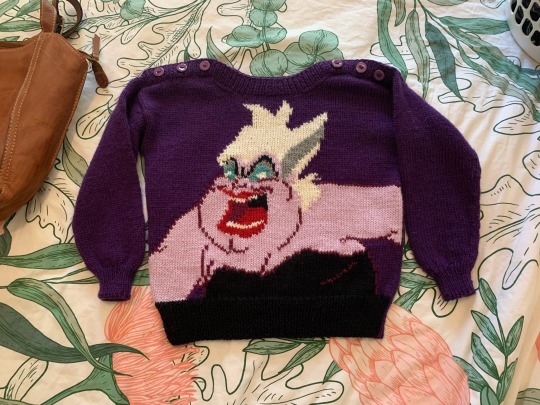
I finished this one for a friend's 7 year old and delivered her today.
Ursula from the Little Mermaid, I found the pattern book in an op shop in Kyneton on the way up to the Australian Sheep and Wool Show last July. Of course I had to stop at the woollen mills that very day and buy yarn. She is knitted in Bendigo Woollen Mills Classic 8ply for the majority of the colours, the rest of the colours are yarn from the back room which looked and felt and handled awfully similar to the Classic (and also machine washable to boot).
She took about 6 months from cast on to sewing the buttons on with me spending the majority of that time avoiding weaving all the ends. I am convinced that the pattern designer had a sadistic streak to them as there were heaps of spots with only 3 or 4 stitches in a colour even after me simplifying the pattern down to about 4 less colours. The pattern did specify a massive amount of embroidery which I left off because my embroidery skills are non-existant.
Wah-lah!
23 notes
·
View notes
Text
Top 6 Castlevania Protagonists
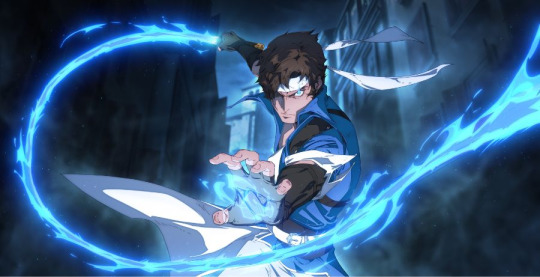
It’s still May, so I’m still going on a Dracula-thon for the month. So, I guess it’s time for some more Castlevania focus!
A while back, I did a list of my Top 15 Castlevania Characters, overall. The problem with that list is that it was actually really, REALLY difficult to sort out the rankings for most of the characters involved, for lots of reasons. One of them is that the Castlevania franchise has gone through so many evolutions over the years, with no less than three separate continuities (more if you count a few of the one-off non-can games), each with its own unique cast of characters, as well as different spins on characters that pop up throughout the series as a whole. I therefore decided it was a good idea to revisit the idea, and simplify things by splitting the concept of the list into two separate, smaller lists: one for the protagonists of the series, and one for its antagonists. This is the former of those lists.
Now, when I say “protagonists,” I’m referring to the MAIN protagonists. I’ll be judging what counts as a main protagonist via the games, since that is where the franchise originated: to qualify for this list, the character must be a playable central character in at least one of the video games. This will not count characters who are just side figures, such as Saint Germain, nor will it count characters who can only be used as playable figures in a special mode, such as Julius Belmont: these two examples, and others, are certainly awesome in their own ways, but they aren’t the characters we really focus on in the Classic games primarily, and are also usually not central figures in other spin-off works.
With that said, there are still quite a lot of characters to choose from. Some of them are Belmonts, some of them are other heroic figures. Some of them wield whips and chains, while others wield swords or magic spells. All of them, however, typically share the same basic goal: to protect the world from the evils of Dracula and his children of the night. I’m keeping this list relatively brief, simply because - after a certain point - all of the characters sort of bunch up together, and it’s hard to keep track of them all and how they would rank. So, with that said, I present to you all my Top 6 Main Protagonists from Castlevania!
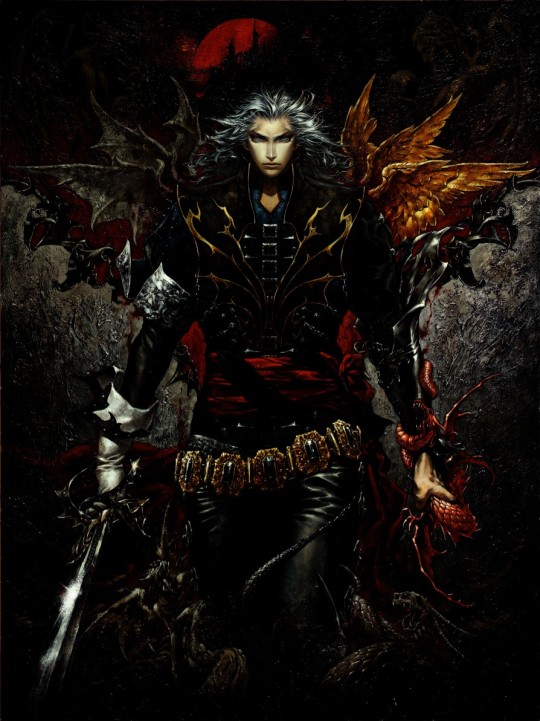
6. Hector.
Hector is the main character in “Curse of Darkness,” one of my favorite 3D-style Castlevania titles. He is a Devil Forgemaster: a human who has the power to summon damned souls from Hell, turning them into monstrous soldiers. Prior to the game, Hector was actually one of Dracula’s war generals: one of the few human servants the undead Count had. However, when Hector felt that the vampire’s bloodthirsty plans to destroy the entire human race had become too much for him to handle, he fled the Castle. This inadvertently helped to allow Trevor Belmont to destroy the Count. Years later, in the events of the game, Hector returns to Castle Dracula, in order to settle a score with his old rival and arch-nemesis: fellow Forgemaster, Isaac, whom Hector blames for the death of his wife. In the process, Hector discovers schemes to bring Dracula back from the grave, and thus must use the powers he once used to help the Count to defeat him before his plans can begin again. I love characters who have redemptive arcs or dark pasts they have to overcome; Hector is a great example of this, as he used to be a villain - one of Dracula’s top agents. This makes the story of his return to the Castle, his quest to stop the monster he once served, all the more interesting. Hector is one of a few characters on this countdown who was later adapted into the animated series; like many of the characters there, this version kept many of the basics of his backstory and appearance intact, but also took some unique liberties. In “Curse of Darkness,” Hector is a stoic and aggressive warrior, prone to following his heart more than his head. In the Animated Series, he’s reimagined as a more reserved, passive-aggressive, scheming character, who has a story arc of growth and maturity. Both versions are excellent and worthy of praise.
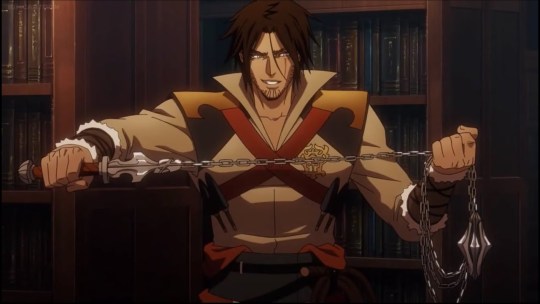
5. Trevor Belmont.
Speaking of the animated series, it’s largely BECAUSE of that continuity that this character makes it onto the list. The Castlevania series - at its core - is the story of two basic, feuding factions: Dracula vs. The Belmont Clan. The Belmonts are a family of monster hunters who have fought with Dracula time after time, across the centuries: every time he is resurrected, a Belmont is usually somewhere trying to send him back to Hell where he belongs. However, in my opinion - and this is going to be VERY controversial for Castlevania fans, I suspect - most of the actual Belmont CHARACTERS aren’t really all that interesting. When Trevor started out, he was no exception: in “Dracula’s Curse,” he is one of four playable characters, and I would argue he is one of the least interesting of the three. What little we know about him makes him pale in comparison to the likes of Alucard, Dracula’s own son with vampiric abilities, or Sypha, a sorceress with various magic spells at her fingertips. (Or even Grant, who is a stab-happy pirate.) This was in the early stages of gaming history, and back then, characters typically weren’t all that well-developed: they were mostly just avatars for the player to use to explore or fight with, and that was basically Trevor’s role. Over the years, however, as the games progressed and evolved, Trevor DID start to develop: more layers were added to his personality and his character. In the Classic games, Trevor became one of the mightiest of the Belmonts: a serious and charismatic warrior who was somewhat jaded by his battles, but could still be reasonable and recognize the good in people around him. But it was with the Animated Series that I feel Trevor really became a fully-rounded character on the whole: the series took those jaded qualities and expanded upon them, as Trevor starts off as a disillusioned soul with a tragic past. Over the course of the series, through facing increasingly bitter and brutal trials, he learns to accept his role and status as a hero. He’s easily my favorite of the "Classic" characters who bear the Belmont name, but since a big portion of that comes from the TV series more than the original games, I didn’t feel I could rank him TOO highly.
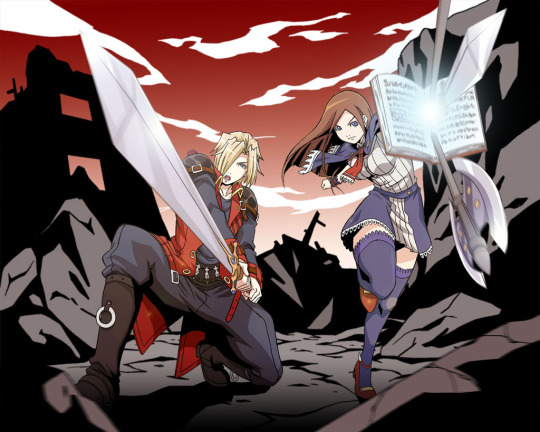
4. Jonathan Morris & Charlotte Aulin.
I was originally JUST going to give this slot to Jonathan, but after consideration, I decided to give both of the main protagonists from “Portrait of Ruin” their fair share of credit. This is largely because so much of what makes “Portrait of Ruin” great comes from the fact it DOES have two main protagonists: the gameplay relies on a sort of buddy system, with various obstacles that can only be overcome by using both characters, and with each character having their own special set of skills. However, not only is this doubling of protagonists important to the gameplay, it’s also an intrinsic part of the story. These two have a sort of “brains and brawn” relationship: Jonathan is the latter half of that equation. He is prone to anger and excitement, always itching for a fight, and tends to use his fists (or his sword, or his whip) before his head. He follows his heart and his instincts before all else, and while sometimes this serves him well, other times it gets him into trouble. Charlotte is the opposite: she is EXTREMELY smart, but also extremely kind and empathetic. However, she’s also much more cautious - sometimes to a fault - and has a habit of rambling and “geeking out” about things, which can sometimes cause problems in its own way. The two balance each other beautifully, both with their contrasting personalities, but also their abilities: Jonathan is very much a straightforward fighter, using melee-focused attacks and bodily force. Charlotte is a brilliant young mage, who uses spells and her wits to solve problems. I should also point out that Jonathan is actually a descendant of Quincey Morris, one of the main characters from the original novel of Dracula, and one of the few American main characters of the franchise: as an American myself, and as a HUGE fan of the Stoker novel, I’ve always appreciated these facts quite a lot. They definitely earn him a soft spot in my heart on their own.
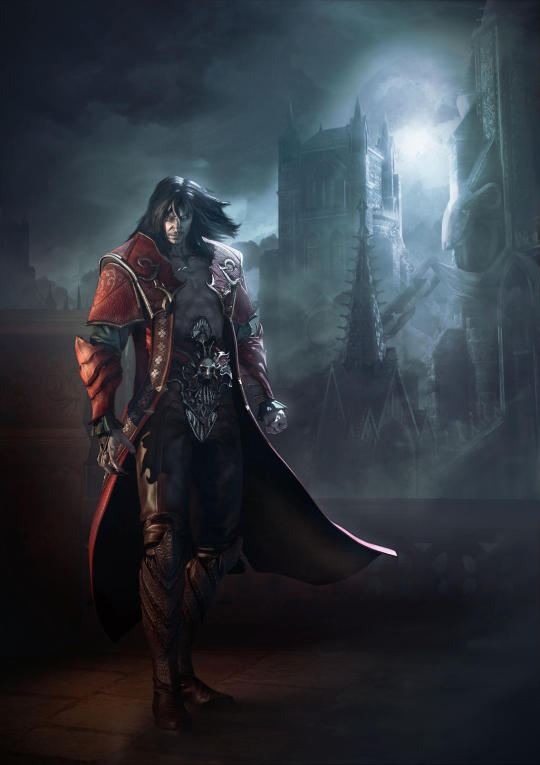
3. Gabriel Belmont, a.k.a. Count Dracula.
Most Castlevania games focus on the main characters fighting Dracula…but what about a game where you play AS Dracula? This was the approach the “Lords of Shadow” series took. LoS was an attempt to reboot the game series, with its own lore and aesthetic approach, inspired by “God of War.” Fans remain mixed about the trilogy of games that came out of this trial, for a lot of reasons. Personally, while I think the reboot trilogy was flawed, I still think it was interesting and had lots of merits all its own…one of them being that instead of Dracula being the main villain of the games, in two out of three titles, Dracula is actually your main character. In the first game, “Lords of Shadow,” you play as Gabriel Belmont: the patriarch of the (weirdly Scottish now) Belmont line. It’s ultimately revealed that, after the tragedies and tribulations that occur for Gabriel in this first game, along with some later misadventures found via DLC story arcs, he actually BECAME Count Dracula. In “Lords of Shadow II,” the player now controls Dracula in full force, as he is resurrected in the present day to face old enemies in a new world. Gabriel/Dracula is the quintessential anti-hero: while he does and has done a lot of terrible things in the games, he’s not depicted as a straightforward villain. Instead, he’s a tortured soul who is struggling to figure out who he really is and what his purpose in the universe should be, and has to deal with inner demons (some literal, as well as figurative) that he cannot fully control. Top it off with the character being voiced by Robert Carlyle, and it’s pretty clear why this was such a fun ride. I know placing this character in the Top Three is going to be another controversial decision, but at the end of the day, getting to play as Mr. Gold as Dracula is all this NEEDED to make my personal highest ranks.
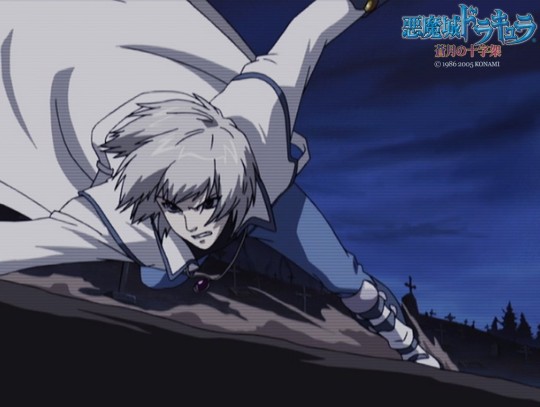
2. Soma Cruz.
As much as I love playing as Dracula in “Lords of Shadow” and its sequel…technically speaking, this character from the Classic era of the games did it first. Soma Cruz is the main character in “Aria of Sorrow” and its sequel, “Dawn of Sorrow.” He is a relatively normal young man from Japan, and is depicted as what might be termed a sort of "nice delinquent." He's ready to fight when it comes down to the wire, and he's not necessarily the most elegant person in the world, but he isn't a bully or a thug. (He also has an AWESOME fashion sense, and seems very proud of that.) He's protective of his friends, tries to help people in trouble, and gets flustered at the attentions of his best friend/love interest, Mina. (Hello, Stoker reference.) However, it’s eventually revealed that Soma has strange powers he never realized before: he’s naturally gifted with weapons he’s never before touched, and has the ability to consume the souls of the enemies he defeats, as well as use magical abilities like it’s second nature. It’s eventually revealed that the reason for all this is a dark one: Soma is actually the reincarnation of Dracula himself, and the Count’s evil spirit essentially lives, dormant, inside his body. If Soma isn’t careful, he could be lost to that inner darkness, and the good person he is will effectively die, with Dracula - memories and powers all intact - being reborn. The games thus become a story of Soma struggling with his own inner darkness, fighting to avoid giving in to temptation and stop himself from becoming Dracula. He has to not only face opponents who want to try and bring the Count back, but also those who would destroy him in a misguided attempt to prevent that from happening. It’s up to the player if Soma succeeds and remains the good, heroic spirit we all care about, or fails and allows himself to become the King of the Vampires. It’s a magnificent concept, which allows for all kinds of fun possibilities in terms of character, story, and gameplay alike. It’s not a surprise that Soma makes the top ranks for many people’s lists of their favorite Castlevania characters, and while he isn’t my personal number one…hey, second place ain’t half bad.
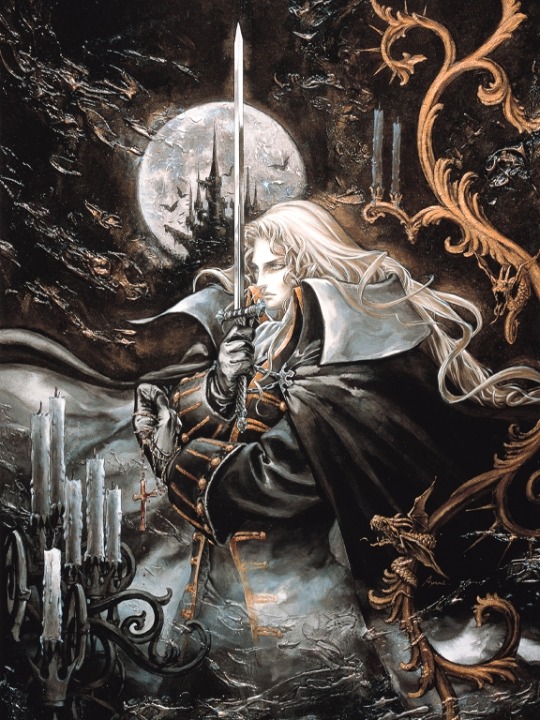
1. Alucard.
Alucard is a character who was automatically interesting from day one, just because of a simple fact: he is the Son of Dracula. The offspring of the main antagonist for the entire series, who has to fight his father to save the world. That is a compelling concept no matter which way you look at it, and since his first appearance in “Dracula’s Curse,” he has only continued to develop and become more interesting. In the Classic series, his shining moment was in “Symphony of the Night” - one of the most lauded Castlevania games, and the beginning of the “Metroidvania” approach to the series. In that game, Alucard is the main character, and the story goes into great detail about the relationship with his family and the reasons he chooses to fight against his own father. In later games, Alucard would continue to pop up, usually as a sort of guide or supporting player for other characters who needed a helping hand (such as Soma, our previous pick). Being as nigh-immortal as Dracula himself, he was just as capable of continuing the battle. In the “Lords of Shadow” series, the character was conflated with Trevor, to fit the new lore of the reboot: in that version, Trevor is Gabriel’s son, and gains the name “Alucard” when his father - not realizing who he is - transforms his son into a vampire, in order to save him from true death. The two start off as enemies, but eventually become allies. Then there’s the Animated Series, which returned to the roots of the Classic games, but took a few interesting twists: after succeeding in destroying his own father, with the help of Trevor and Sypha, Alucard ends up going on some misadventures on his own, as - much like Trevor and many other characters in the series - he is forced to try and figure out where he stands. He has no mother, no father, and is utterly alone in the universe; this causes him to start to lose his way, and it seems like he could potentially end up just as wicked as his father…but eventually, he manages to find the light and prevails as a hero once more. EVERY version of Alucard is great, in my opinion (though I personally think my favorite is the Classic version, overall), because the basic struggle he has to go through is such a simple and compelling one. The rivalry between father and son, and the way their relationship is depicted in each rendition, is ALWAYS fascinating to see, and combining that with Alucard’s rarely-meddled-with design (which is absolutely awesome) and his vampiric capabilities, he instantly becomes an intriguing figure. Alongside Soma, he’s many people’s choice for the best main character in the series, and I am of total agreement there. There’s no doubt he is My Favorite Protagonist from Castlevania.
HONORABLE MENTIONS INCLUDE…
Richter Belmont.
The main character of “Rondo of Blood” (and its remake, “Dracula X Chronicles”), as well as a secondary figure in some other games. Probably my favorite Belmont after Trevor, and for me, personally, the most visually iconic. I should point out I haven't actually watched "Castlevania: Nocturne" yet, so maybe when I get a chance to see that show, Richter might take Hector's place in the top ranks.
Leon Belmont.
In the Classic games, Leon is the progenitor of the Belmont Clan. He appears as the main character in “Lament of Innocence,” the prequel to the entire Castlevania series at that time, which tells the story of how the Belmonts’ feud with Dracula began. “Lament of Innocence” is his only proper appearance to date.
Sypha Belnades.
Much like Trevor, it’s primarily thanks to the Animated Series this character gets into the ranks. We don’t really know much about Sypha in the Classic games, and she is only briefly alluded to in the Lords of Shadow reboot. In the Animated Series, however, she is one of the main protagonists, and is just as interesting as Trevor and Alucard.
#list#countdown#top 6#favorites#best#dracula month#castlevania#heroes#protagonists#video games#animation#tv
14 notes
·
View notes
Note
Alright, I will be honest:
I don't like Black&White saga cause it feels like flopoed retcon/reboot of pokeanime. Like, in the beginning it cut ties to previous sagas and regions. Like, after whole THE BUILD UP in Sinnoh, it felt like Ash got robbed. Also doesn't help that in beginning they isolated Unova pokemon from previous generations. And the thing is, is that 5 gen pokemon design already stylistically different from previous ones: more round, simplified.
Also, it didn't help that relationship with rivals are less close and tense than in Diamond&Pearl. Like, all other characters beside main trio feels shallow and caricatures. In Sinnoh, both Ash and Dawn learned something from their rivals, Paul and Zoe were REALLY IMPACTFUL to them. But when we compare Iris and Dragon huntress (yes, I don't even remember her name)... That's basic. Like, Iris's rival surved as plot tool few times at best.
But second part of saga is better (*cough - cough * cause Cynthia and Dawn came back *cough- cough*) : old pokemon are back, we see mythical pokemon in action. Also, I enjoyed Decolora arc!
Good points of BW:
I like Cylan and Iris. For Iris in particular... She feels like Misty's other version, but in a good way. I also like her story arcs with her team, like damn, homegirl got her own Suicide squad in pokeworld 😂.
Also, there's Team R... One one hand, it's was hard for me to see them drop comedy tone. On another hand, they demonstrated us how much dangerous they can be! Like, they got their business! Our trio was more menacing than whole Team Plazma, honestly 😅.
All in all, my main issue is that Black and White drop most of connections with Diamond and Pearl. Like, transition was too DRASTIC. But I do understand, that there ate people who adores 5 gen. I mean, I heard that 5 gen games was top tier. It's just, unfortunately, I stsrted to dwell into pokemon games since 6 gen, so I was unable to even play Black and White. Maybe in that case I watched anime in different context.
Also, I really like movies in that saga! Like Keldeo and Mewtwo (or Newtwo ( if you know you know)) put everything in their movies, and Victini's one with TWO DIFFERENT VERSIONS was low-key something in cinematic universe level.
... That was looong ask, but I really need that out of my chest 😅
Nah, dont worry, go and vent its the first step to overcoming trauma lol I joke but seriously, if everyone sat down to understand what they dislike and like about a season like that, things would be so much simpler :v
BW is totally an attempt to a soft reboot! But there's one thing I feel folks often forget: The games themselves were that too!!
The lack of pokemon pre gen 5 was something that came from the games, as unova was the first region outside of Japan. Pokemon company was trying to start anew from all sides and that ended up affecting the anime the most because for some reason, it was decided that they would star anew, but keep a familiar face in Ash.
And then we have the fact that the BW games got a sequel immediately after, Black and White 2, and the story on those was directly connected to the first games, showcasing an Unova 2 years after BW1 (highly reccomend them btw, some of the best overarching story in pokemon games ever)
And like, the anime started with the narrator just saying Ash was still 10!! Someone surely made that a rule in the background, so how could they tell the story of a Unova 2 years later with a main character that just couldn't age?
So the writers just had to do their own thing. And probably made up so much of it halfway and also explain why they just scrapped so many characters of the day post league. They just wanted some time for people to forget the first half of BW to try and implement things from BW2.
And that's the thing, this issue is not from BW only. We know for a fact that there were plans for Ash to leave the anime during Johto, but they couldn't just say goodbye to him, so he stayed. Black and White was just the culmination of that decision. And I feel like hating on it alone is just… not aknowledging that pokeani is flawed from the get-go yknow?
What made BW that weird is what made Ash and Serena and the Kalos loss weird, what made journeys weird and what made 2beamaster miniseries that FUCKING WEIRD.
BUT GOSH TRIO!! Now the way those 3 were handled in the season is one thing I can't excuse lmao
People love to talk how out of character Ash acts this season, even though is not even that OOC when compared to pre DP, but TR were the ones that felt like complete different characters! And while I enjoy the whiplash of Ash gang doing silly things overlapped with very serious evil dutiestm, I feel like that that was a bad decision throught and throught. I get that at first they wanted a Team Rocket vs Team Plasma situation, but doing that with the TRio is just so weird.
HELL YEAH, I LOVE THE NEWTWO MOVIE! It makes no sense but gosh Mewtwo2 and genesect's relationship is just so ADORABLE i love them so much. Is those kind of stuff that makes me sad about BW, folks see a mewtwo that is not the main one and they dont give it a shot, but is such a heartwarming story in the end.
#answered asks#long post#|→ not not#hot take which is not a take at all im just joking BUT#DP is the odd one out#lmao#if DP didnt exist i feel like the transition from OG-DP ash to BW-JN ash would be better accepted
10 notes
·
View notes